Janice Horton's Blog, page 13
June 11, 2023
Travelling Asia With KUHL Clothing
When independent clothing company KUHL (pronounced COOL!) approached me to ask if I’d ‘travel test’ their quality clothing on my recent Grand Asian Adventure – a six-month multi-terrain mega-trip through many Asian countries via flights, buses, trains, boats and taxi tuktuks – I was intrigued enough by their friendly email to check them out.
I decided to accept their partnership offer and to become a KUHL Ambassador on my Grand Asian Adventure, not just because their clothing is of the highest quality, but because I feel the company’s philosophies are a great match with my own.
FREEDOM OF MOVEMENT: PASSION FOR TRAVEL AND THE OUTDOORS: SUSTAINABILITY AND ENVIROMENTAL AWARENESS.

KUHL “source only the finest materials from environmentally conscious and ethically minded partners. In addition, production facilities must also meet high standards in their practices and procedures.”
KUHL don’t offer ‘sale’ or ‘discounts’ because they will not over-produce. “Over production is a waste of working capital, resources, and is overall, environmentally unsound. We make a great product for a fair price. KÜHL will never settle for second best.”
KUHL do offer FREE SHIPPING on US online orders over $100. See T&C.
TRAVELLING ASIA WITH KUHL CLOTHINGKUHL gifted and send out to me my choice of outfit from their extensive range of unique and feminine clothing designed for outdoor wear in return for my honest opinion and my evaluation of their product. As I was travelling light on my Grand Asian Adventure – hand luggage only – I chose carefully from KUHL’s women’s range and I chose a pair of Kontour Flex Denim Shorts 6″ and an Adele Shirt in Natural.
These would be my ‘go to’ and ‘travelling clothes’ for the next six months.
I expected them to not only look STYLISH and to FIT WELL but to be SUPER COMFORTABLE and HARD WEARING. As I was only travelling with hand luggage on this trip, every item I took had to be ‘a right choice’ so to test out style, fit, and comfort factors, I wore my KUHL shorts and shirt outfit several times before I left and soon decided they would be perfect travelling attire.
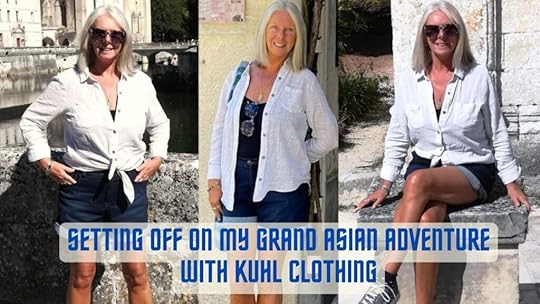 TRAVELLING ASIA WITH KUHL CLOTHINGMY KUHL REVIEW
TRAVELLING ASIA WITH KUHL CLOTHINGMY KUHL REVIEWMy review is honest and unbiased and my recommendation is well and truly tried and tested!
KONTOUR FLEX DENIM SHORTSKONTOUR FLEX DENIM SHORTS (I wear UK size 12) were super flexible and stretchy and highly respectable in that they are not too short for a middle-aged woman to wear as casual attire. I realised I could wear them on flights to be cool and comfortable. I could easily wear them while doing walking tours in cities and also while sightseeing. They are so versatile that I could wear them hiking mountains or trekking jungle terrain. They washed really well and I put them in a laundry twice a week. The blue colour never ran and stained my other clothes in the wash. The button on the waist band never came loose. They were lovely and stretchy but never lost their shape and always felt soft and comfortable and well-fitting on my waist.
The only issue I had with these shorts (UK size 12) was that the cut on the legs was a little generous for me. I have skinny thighs! So, as you can see in some of my photos, I turned up the legs at first to show the underside of the denim fabric.
Note: As the sizing is on the generous side (I’m usually a UK size 12/14) and these shorts are stretchy then I recommend you size down – if like me you’re between sizes.
However, in Vietnam, our homestay host was a clothing tailor and so I had her adjust and tailor the legs to fit me. She did this by simply adjusting the outer seams of the shorts a little and afterwards they fitted me perfectly!
 The ADELE
The ADELE SHIRT
SHIRTThe ADELE SHIRT is ultra-soft, lightweight, and breathable pure 100% cotton. (I wear KUHL size M) It features a slub pin-stripe texture for a polished yet easy going look. I loved the pin-strip look and the soft feel of the fabric. I could button back the sleeves or wear them long. I could tie the shirt at my waist for a totally different look. And, believe me I did all of those things – and more – as I travelled all around Asia. I also wore it without the shorts as a light jacket or a beach-shirt.
SHIRT is ultra-soft, lightweight, and breathable pure 100% cotton. (I wear KUHL size M) It features a slub pin-stripe texture for a polished yet easy going look. I loved the pin-strip look and the soft feel of the fabric. I could button back the sleeves or wear them long. I could tie the shirt at my waist for a totally different look. And, believe me I did all of those things – and more – as I travelled all around Asia. I also wore it without the shorts as a light jacket or a beach-shirt.
I had no issues with this shirt at all. It washed well. Never needed ironing. Buttons never came loose. I absolutely loved it.
THE RIGHT CLOTHES IN ANY TERRAIN AND ANY CLIMATE!In colder climes, as you’ll see in some of these photos (e.g. South Korea in January and Japan in early March) that I wore warm leggings or thick black tights under my shorts. I also wore a close-fitting top under my Adele shirt for an extra layer and used my beach sarong as a neck scarf. I never felt that I couldn’t wear my KUHL outfit!
 THANK YOU TO KUHL
THANK YOU TO KUHLThank you to KUHL for supplying me with my travel outfit on my SIX MONTH non-stop Grand Asian Adventure and for reaching out to me to wear their WOMEN’S OUTDOOR CLOTHING and be their KUHL AMBASSADOR on this trip. KUHL say they are ‘BORN IN THE MOUNTAINS’ but I feel that I can also endorse their clothing as ‘CHIC IN THE CITY’ too!
I say KUHL is COOL so click the banner and check out their WEBSITE right now!

THIS POST CONTAINS AFFILIATE LINKS
I want you to know that if you use any of the links on this page and on my website that these are affiliates links – this means if you use my link to the KUHL website and then choose to buy a product from KUHL – I will receive a small commission. BUT this does NOT affect the price of your purchase at all. It will however help me to run this website. Thank you for your support.
MY GRAND ASIAN ADVENTUREFind out about the countries I visited and all the fabulous experiences along the way (lots of posts coming soon!) on this website. You can also FOLLOW ALL MY ADVENTURES by subscribing to my newsletter (sign up via the pop up or using the box on the sidebar) and by following me on my social media channels.
For midlife travel inspiration and ageless travel adventures!
#travelwithme #thebackpackinghousewife

The post Travelling Asia With KUHL Clothing appeared first on The Backpacking Housewife.
July 24, 2022
My Top 5 Wine Tasting Chateaux in Bergerac France
Touring fabulous vineyards along a classic ‘route des vins’ for wine tasting is sure to be right at the top of an exciting list of must-do experiences for many people holidaying and visiting France, and for this reason I have specially curated for you, my own Top 5 favourite wine tasting chateaux in Bergerac France.
I’ve been fortunate to live like a local in France on and off for several years (while housesitting) and, as I write this article, I’m preparing to return for a few months of housesitting in late summer.
The part of France that I’m personally most familiar with is The Dordogne.
The Dordogne Department is the third largest Department in France and is named after the Dordogne River, which is the third longest river in France. The Region is also known by three different names because it’s also known as Nouvelle Aquitaine and as The Perigord (the original name preferred by the French people) because it was formerly known as The Perigord Province.
The name Perigord itself derives from the name Perigueux – the stunningly beautiful and historically important current capital city of the Dordogne Department – an area which extends to Sarlat in the east and Bergerac in the south.
And, it’s in the beautiful and medieval market town of Bergerac in the south of the Dordogne, where you will find wine treasures in the form of white, red, and rose.
 Bergerac
BergeracWhile I’m back in France later this year, I’ll be staying in a small village not too far from Bergerac. During previous visits to this part of France, whenever we’ve had friends or family visiting us during the spring and summer and early autumn months, we’ve always included a wine tasting tour in the Bergerac wine producing area as a highlight in our visitors holiday itinerary.
MY TOP 5 FAVOURITE WINE TASTING CHATEAUX IN BERGERAC FRANCESo, this bespoke tour of FIVE fabulous wine chateaux in the Bergerac area, is my own personally curated and handpicked and especially recommended and (delightfully oh-so-familiar) winery, vineyard, and wine tasting tour!
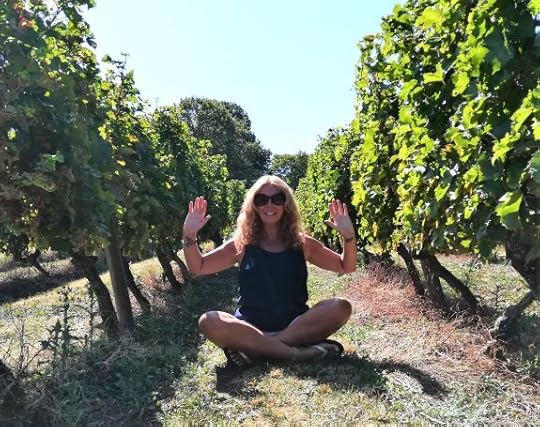 In the vineyard!
In the vineyard!These wine tastings at my bespoke tour of five wineries are offered free of charge to visitors (correct at the time of writing) but, of course, I’m sure, that after tasting these fabulous wines and learning about how the vines are cultivated and grown and the wine is made, you’ll want to purchase a bottle or two or three or four!
 The Backpacking Housewife and Backpacking Husband in the vineyards
The Backpacking Housewife and Backpacking Husband in the vineyards
TIME AND DISTANCE: Just one of the wonderful things about this bespoke vineyard tour is that it can be easily managed over the course of an afternoon (depending on from where you are driving) because the total driving time between each of the chateaux from (starting at Point A and ending at Point E) is approximately 40 minutes. This allows plenty of non-driving time to allow for chateau viewing, inspecting vines and learning about grapes, wine tasting, and wine purchasing!
Of course, depending on from which direction you are driving, you can easily reverse or change the the order in which you visit each chateau.
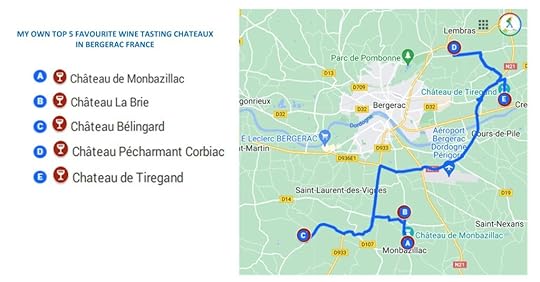
Click on the interactive GOOGLE MAP for more details on driving directions and distance.
MY TOP 5 FAVOURITE WINE TASTING CHATEAUX IN BERGERAC FRANCEA NOTE ABOUT TIMING: I’m recommending you start your wine tasting tour apres-midi (in the afternoon) to avoid the regulatory French two-hour lunch breaks and the closure common to most establishments in France at midday.
If this doesn’t suit you, do check the website links for the opening days and times for each chateau throughout the season as they are often subject to changes throughout the year and to avoid any disappointment.
We’ve never had to book and prearrange our visits and have simply showed up for wine tastings but again, if it’s the busy summer season, then perhaps it might be sensible to visit to the chateau’s website to check things out while you’re initially planning your wine tasting tour.
A PRE-LUNCH TIME TOUR TIP: If you do prefer to set out in the morning, then I might suggest you start the tour at Point A (Chateaux Monbazillac) because in the high summer season they often remain open the whole day and during lunch time (check the website for opening times during your planned visit). That way you can enjoy the wine tasting on offer in the visitor’s centre before lunch and then, having brought along your own picnic, enjoy déjeuner en plein air (an outdoor lunch) in the beautiful and elevated grounds of the chateau with views over beautiful Bergerac or even amongst the vines, before heading on to the next chateaux in the wine tasting tour during the early afternoon.
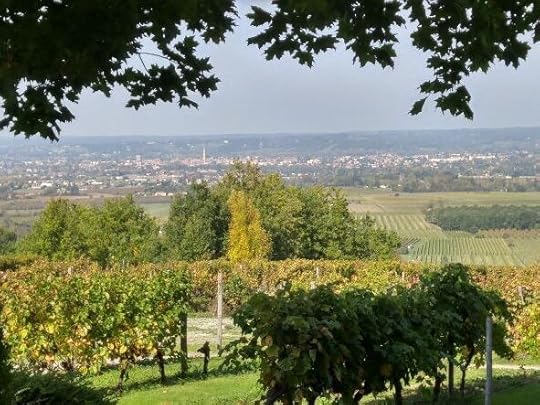 Views from the vineyards to BergeracA Note About Drinking and Driving
Views from the vineyards to BergeracA Note About Drinking and DrivingPlease note that I would NEVER advocate drinking wine and driving a vehicle. I must advocate that you either take a taxi for this tour or do as we do and allocate a non-drinking driver.
THE CHATEAUX: I’ve chosen these particular 5 Wine Tasting Chateaux in Bergerac for the eclectic mix of impressively grand – surrounded by its own vast vineyards in an elevated position with views over the whole of the Bergerac area (Chateau Monbazillac) – to the more homely ‘farmhouse style’ chateaux, with fabulously long histories of making excellent wines (Chateau Corbiac, Chateau Belingard, and Chateau de Tiregand) compared to the perhaps more classically tres chic and modern wine tasting experience offered by Chateau La Brie.
THE TOUR: The tours I’ve chosen for you offer both French and English-speaking wine guides. To help with the navigation, I’ve included these useful Google Maps to show the location of each chateau and the distances involved for this tour of my Top 5 Favourite Wine Tasting Chateaux in Bergerac. Bon appetite!
MY TOP 5 FAVOURITE WINE TASTING CHATEAUX IN BERGERAC FRANCE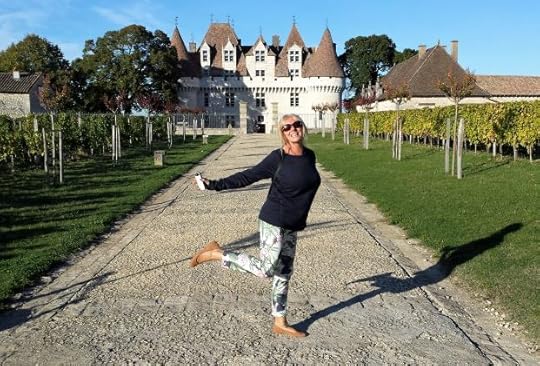 The Backpacking Housewife at Chateau MonbazillacA: Chateau Monbazillac
The Backpacking Housewife at Chateau MonbazillacA: Chateau Monbazillac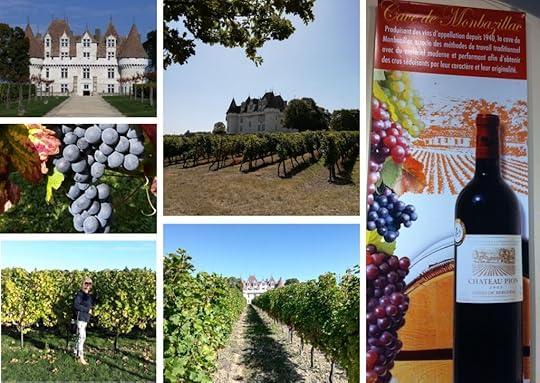 Chateau Monbazillac
Chateau MonbazillacChateau Monbazillac is one of the most beautiful chateaux to be seen in the Monbazillac commune. Standing on its lofty escarpment, surrounded by its 3500 hectares of vineyards, it looks like a castle from a fairy tale.
The chateau with its turrets and roundels is visible long before you reach it and once you’ve parked up in the shaded wooded carpark, you’ll be delighted to find the chateau is viewed and approached via a long walkway flanked by well-tended vines.
Built in 1550 and listed as a historical monument, castle tours to view the finely decorated rooms and artwork, are available. But, despite beauty and the history of the chateau, it could be argued that Monbazillac is far more celebrated for its highly reputed and elegant dessert (sweet) wine.
Monbazillac wine is without doubt the most famous wine produced in the Dordogne.
The vineyards here can be traced back to the even earlier times of Benedictine Monasteries of the 11th century. The wine is produced from Semillon, Sauvignon Blanc and Muscadelle grapes.
Interestingly, Monbazillac vineyards are owned by a cooperative of fifty winegrowers and so there are many wonderful wines – reds, whites (both dinner and dessert wines) and rose – to taste and to buy on site, as well as souvenirs to take home to remind you of your visit long after the last drop of wine has been finished.
B. Chateau La Brie Wine Tasting at Chateau La Brie
Wine Tasting at Chateau La BrieChateau La Brie was once privately owned but the estate was bought in 1962 by the towns of Bergerac and Monbazillac in order for the Ministry of Agriculture to establish an wine high school to effectively train the winegrowers of tomorrow.
The estate officially recognizes environmentally friendly practices has been partially certified in Organic Agriculture Since 2010. Since 2013, Château la Brie has held level III of the HVE (High Environmental Value) standard. Their aim is to be fully certified organic from the 2023 vintage.
Château La Brie has been regularly rewarded for the quality of its wines.
The different types of wine produced at Chateau La Brie are: Monbazillac – Bergerac Sec – Côte de Bergerac Moelleux – Bergerac Rouge – Bergerac Rosé.
Chateau La Brie’s modern winery complex can be found just south of Bergerac on the Monbazillac road and offers a friendly wine tasting experience and a range of it’s wines for tasting and for purchase. The wines here are, in my opinion, fabulous and sold at a very affordable price.
C: Chateau Belingard Chateau Belingard
Chateau BelingardChateau Belingard is a family home and sits rather grandly on the slopes of rolling hillside on the left Bank of the Dordogne River. The views from the front aspect of the chateau and over the valley and of the vineyards are breathtakingly beautiful.
The chateau was restored in 1820, and since then, several generations have been and gone.
Today, the chateau and the terroir and the vineyards at Chateau Belingard, are thriving from the love and care and devotion bestowed upon them by seven generations of the same family.
Since 1936 the wines from Chateau Belingard belong to the AOC : Bergerac Blanc Sec – Bergerac Rose – Bergerac Rouge – Côtes de Bergerac Rouge – Côtes de Bergerac Blanc – Monbazillac.
Chateau Belingard is open all year and is delighted to welcome wine lovers, connoisseurs and experts, or just tourists with a passing interest in wine. You will hear all about wine-growing and winemaking work as well as the 200-year history of a family dedicated to its Monbazillac and Bergerac land. I did a self-guided tour of the winery using a headset and recording device provided as a pre-courser to the tasting. I can heartily recommend this wonderful winery and wine tasting experience.
D: Chateau Corbiac Chateau Corbiac
Chateau CorbiacChateau Corbiac is the ancestral home of Cyrano de Bergerac of literary fame. This beautiful property has remained well loved for centuries and seventeen generations of the same family. The current Corbiac family traces its heritage back to 1587.
This ancient vineyard produces Pecharmant wine – a wine appellation for certain wines produced in the hills to the North-East of the market town of Bergerac – and in this wine-growing region, the wines must be made from grapes from these four grape varieties: the côt (malbec), merlot, cabernet franc and cabernet sauvignon. Pecharmant is a powerful, intense, aromatic red wine that ages well.
Pecharmant wine is traditionally seen as the finest wine of this region. It is produced exclusively in the oldest collective of vineyards in the region of Bergerac. At Chateau Corbiac, you will be offered a warm and personable welcome and a knowledgeable guided tasting of their famous and fabulous wines. I was fascinated and educated and most thankful for this wonderful wine tasting experience.
E: Chateau de Tiregand Chateau Tiregand
Chateau TiregandChateau Tiregand: For the past five centuries, the award winning Pecharmant wine at Chateau de Tiregand has been passionately produced by the family and heirs of the Comtesse F. de SAINT-EXUPERY. The grand estate is situated on the Pecharmant slopes and in the heart of the famed Pecharmant vineyards.
Grape varieties: At Chateau de Tiregand the Pecharmant is a blend of Merlot (54%), Cabernet Sauvignon (23%), Cabernet Franc (18%) and Malbec (5%).
At Chateau de Tiregand you will be offered an introduction to the Pecharmant appellation and other Bergerac wines, a walk among the vines, then a visit to the winery to discuss the blending of the grape varieties. Discover the secrets of aging wine in barrels and the arts of the cellar.
We were offered a platter of delicious French cheese to compliment our wine tasting and our wine guide was wonderfully knowledgeable and friendly. The wine is amazing. I bought a fine wine from this chateau especially to drink over Christmas.
If you’re reading this in anticipation of a trip to France to include exploring vineyards and tasting wine, I do hope you find my personally curated and recommended ‘route des vins’ useful, and that you will have a most enjoyable time!
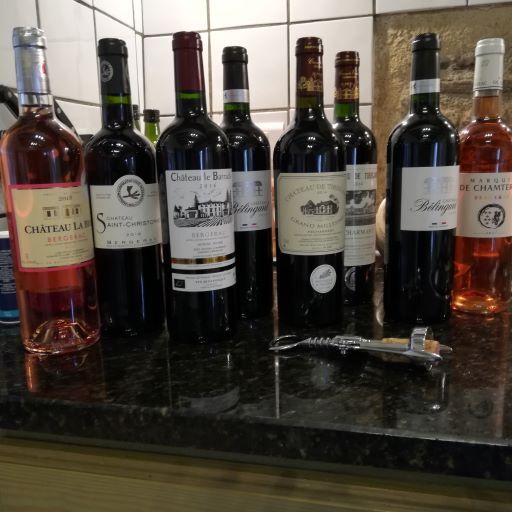 My Bergerac Wine Tour Haul….
My Bergerac Wine Tour Haul…. Are you planning at trip to France and to the Dordogne?
Do you enjoy French wine?
Did you take my tour?
Do let me know!
I’d love to hear from you so drop a comment at the end of this post or message directly using my CONTACT ME link.
Bon voyage!
If you love France and all things French but are not French yourself then you might also enjoy my informative and amusing post TEN THINGS TO DO IN FRANCE TO MAKE YOU FEEL MORE FRENCH as preparation for your next trip to France!

The post My Top 5 Wine Tasting Chateaux in Bergerac France appeared first on The Backpacking Housewife.
June 10, 2022
Travel as A Trusted Traveller with Global Entry
Last Christmas, in preparation for our much anticipated and longed for post-pandemic world travels, the backpacking husband and I gifted each other the price of a Global Entry application.
Travel Planning: How to Travel as A Trusted Traveller with Global Entry WHAT IS GLOBAL ENTRY?
WHAT IS GLOBAL ENTRY?Global Entry is one of the Trusted Traveller Programmes of the U.S. Customs and Border Protection service that allows pre-approved travellers to receive expedited clearance upon arrival into the United States AND ALSO TO MANY OTHER COUNTRIES worldwide. All through using fast and easy to use automatic kiosks.
WHY BE A TRUSTED TRAVELLER?With the media and news reporting stressed out travellers and horrific backlogs and long lines due to extra verifying and checking at airports and planes leaving without the passengers who hadn’t been able to clear security fast enough – even when allowing for the recommended 3 hour time frame for international travel – and then having to stand in queues for hours on arrival to clear immigration, we decided to plan ahead and apply to see if we were eligible for Global Entry status.
THE BENEFITS OF GLOBAL ENTRY STATUSThe Global Entry Trusted Traveller Programme is the perfect travel accessory for those who want to avoid stressful time consuming queues lines and backlogs at airports!
Reduced wait times with self-service kiosks or E-Gates using facial comparison technologies
No paperwork to be filled out by passengers upon entry
Includes the coveted TSA PreCheck®
IS IT WORTH THE TIME AND EXPENSE INVESTMENT?Until we actually used our Global Entry Status for the very first time when we travelled into the USA and I have to tell you that until that point I hadn’t quite fully appreciated all the time and stress it would save us. It was absolutely fantastic.
We deplaned at our destination (Miami) and instead of following most of our fellow passengers to join an already horrifically lengthy queue in the immigration hall – we followed the signs for Global Entry where there was no line at all!
Click here to read about my Road Trip from Miami to Key WestAt Miami International Airport (MIA) we approached one of the Global Entry kiosks.
 Global Entry and APC Kiosks. Photo by James Tourtellotte
Global Entry and APC Kiosks. Photo by James TourtellotteAt the kiosk, I expected to have my passport and fingerprints scanned but due to brand new technology just installed, we just had our faces scanned automatically instead. The machine approved my image and immediately issued a paper receipt for me to hand to the immigration officer, who waved us through and wished us a nice day.
From walking off the plane to getting to the taxi rank took us exactly 12 minutes!
WHO CAN APPLY FOR GLOBAL ENTRY STATUSThe great news is that you don’t have to be an American Citizen to apply for Global Entry status.
Currently, trusted travellers from countries including the United Kingdom, India, Qatar, Germany, Panama, Colombia, Singapore, South Korea, Switzerland, and Mexico, can be eligible. And, I’m sure that list could be added to over time.
And, once you have it, it’s good for 5 years and can be renewed before it expires.
On our departure from Miami we saw that from our boarding passes we were TSA Approved, so joined an expedited line marked ‘TSA’ and breezed through security with priority over other travellers. We didn’t have to take out our electronic items or take our shoes off – or go through body scanners – so getting to our gate was a speedy and stress free process.
Global Entry speeds you through airports like you were royalty or rock stars!
HOW TO GET GLOBAL ENTRYThe process involves applicants being vetted to ensure that they meet the qualifications for the program. As we are UK citizens, we started by applying online at the official Trusted Traveler Programs Website (note the American spelling not used in my own narrative) where we filled in the online form and paid the non-refundable application fee of $100 plus an extra fee (around £42) each to initiate a UK personal security check to see if you have a criminal record or have previously violated any customs laws. Understandably, the checks are extensive and so as you might expect, these take time.
GET FAST PRIVLIGED TRAVEL FOR FREE!It’s well worth knowing that if you have/use certain credit cards – then it’s possible to apply for Global Entry for FREE because many of the fee-based credit cards have additional benefits that can include a Global Entry application fee waiver. So do check your credit card benefits in case you qualify for the waiver and save at least $100.
HOW LONG DOES IT TAKE TO GET APPROVED?From application it took us around six months to get our conditional approval.
After conditional approval you then need to attend an in-person interview.
Interviews are held on arrival at selected Global Entry Enrolment Centres at airports. See the FULL LIST.
After three months of waiting, we were hoping to have our conditional approval in time for our birthday celebration weekend trip to Dublin (where there is a Global Entry In-Person Interview Facility) but that didn’t happen. So, instead we did our in-person interviews on our arrival into the USA from our flight from London.
We sought The Global Entry Interview Counter (at immigration) and we had our formal interviews after which we were given our Global Entry KTN – Known Traveller Number – which would allow the use of Global Entry kiosks.
WHAT TO EXPECT AT THE IN-PERSON INTERVIEWThe official who interviews you will require:
A printout of your conditional approval for Global Entry.Your ID. I used my passport.A form of proof of residence (we used our driver’s licence).During the (10 minute in my case) in-person interview, I was asked why I wanted to use Global Entry and my paperwork was looked over and checked and my photo and fingerprints were taken. Then, I was given my KTN. My backpacking husband was asked more questions than I was (he was interviewed by a different official) and he was asked about the countries he’d visited previously (which he’d already listed on his online application). He too was then given his KTN.
We made a note of our KTN – Known Traveller Number – on the back page of our passports and we’ll make sure that when we book future flights that we quote the number in the relevant section – which will then ensure we also get TSA Approval on our flight boarding passes to further help with a speedy and efficient travel experience.
Because we aren’t US citizens, we are UK passport holders, we knew we wouldn’t be issued with a physical Global Entry Card.
This actually doesn’t matter to us, however, that we don’t get issued a cars because the Global Entry Cards are not actually required at the airport kiosk. They are primarily issued to help with speedy travel entry via land or seaports.
Did you know about Global Entry?
Did you know about TSA Precheck?
Have you always wondered why some people are able to breeze through ‘special lines’ at immigration while you have to line up, tired, hot, breathing other peoples air, in the long queues knowing there’s a possibility that you’ll miss your connecting flight ?
Well, now you do know why and to quote the Global Entry mantra… what are you waiting for?
The post Travel as A Trusted Traveller with Global Entry appeared first on The Backpacking Housewife.
April 12, 2022
Travel Guide to Utila Honduras
The backpacking husband and I are travelling again and it feels wonderful. We’ve returned to the Caribbean Island of Utila. It feels like we’ve come home, because it was right here on this very island, that our fabulous travel adventures first began.
Back then, we’d set out then to explore the islands of The Caribbean and the island of Utila was our special find. It felt like not too many people knew about it. It felt like we’d discovered a secret place in the Caribbean.
Since the, we’ve been around the whole world twice and I’ve actually lost count of how many times we’ve zig-zagged back to this island over the past nine years since the backpacking husband and I sold everything – our home, our cars, and all our possessions – to facilitate a life of nomadic world travel and adventure.
There is a saying that once you’ve come to Utila you’ll never want to leave.
But then again… you do have to leave to be able to come back!
And each time we’ve left, we’ve experienced summer culture shock in going back into the first world and it’s felt like we’ve left a little piece of our hearts here.
So, as we’ve now been back on the island for six wonderful weeks, perhaps it’s time I shared with you – in a postcard style travel guide – my own thoughts on this amazing little island called Utila.
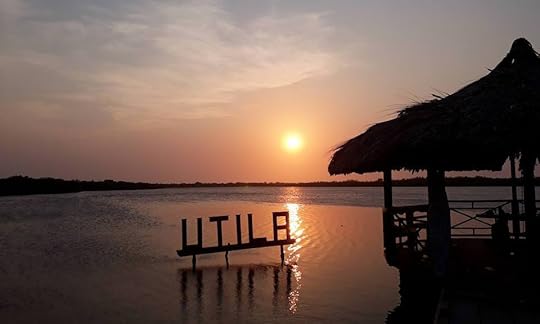 A postcard style travel guide on this amazing little island called Utila. WHERE IS UTILA?
A postcard style travel guide on this amazing little island called Utila. WHERE IS UTILA?Utila – Islas de la Bahia – is the smallest of the Bay Islands, just off the coast of Honduras in the Western Caribbean Sea. Utila is a tiny tropical island paradise sitting on the Meso-American reef – the second largest coral reef in the world – tucked away in a bay where the water is bathwater warm and crystal clear.
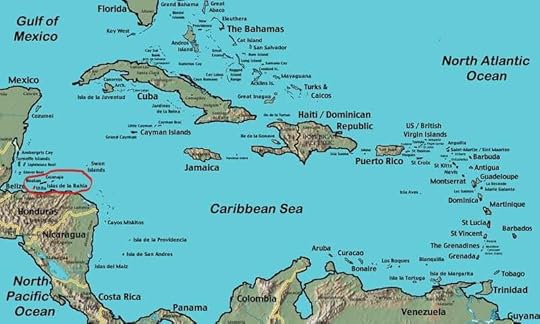 Utila – Islas de la Bahia – is the smallest of the Bay Islands, just off the coast of HondurasTHE CHARM OF UTILA
Utila – Islas de la Bahia – is the smallest of the Bay Islands, just off the coast of HondurasTHE CHARM OF UTILAI’ve heard Utila being described as ‘a Key West of the 1950’s’ as it certainly has a timeless, laid back, and undeveloped feel. Life on Utila is simple – I do mean comparatively basic – and so I do realise that it’s perhaps not for everyone.
Utila is not your stereotypical Caribbean Island. It’s certainly not anything like St. Lucia or St Barth or Barbados. Utila is real. It’s the authentic Caribbean lifestyle. And the people here feel real and authentic too. Island life here makes me feel comfortable despite being it almost unbearably hot, sticky, and humid.
Life can be lived in your swimsuit or in light cotton clothing and flips flops are optional.
It’s certainly not a place to wear your designer clothes, fancy shoes, or your shiny trinkets.
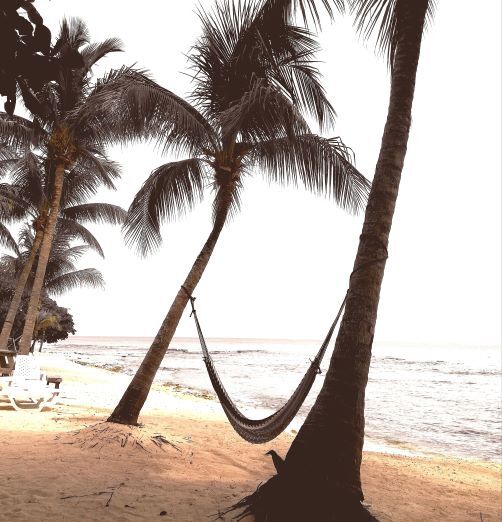 I’ve heard Utila being described as ‘a Key West of the 1950’s’
I’ve heard Utila being described as ‘a Key West of the 1950’s’ On Utila you can just to be who you are… how refreshing!
That’s because you’ll be accepted on this island for being who you are rather than for what you have or what you do or with what or whom you identify with and that’s simply because no one is in the slightest bit interested in all that first world stuff.
The exception to the rule is of course Dr John – Cultural Icon and undoubtably The MOST Famous Person on the island. Doctor John – is the doctor with no T-shirt on – as it goes in the famous song If You Come To Utila. Take a look at the video and listen to the song that made Dr John into the island celebrity that he is today. You can follow Dr John on Instagram!
Travel Guide to Utila HondurasWHAT TO DO ON UTILAScuba Diving: The island of Utila is primarily known as a haven for scuba divers. The very first time we came to Utila was for the scuba diving on the meso-American reef. We stayed three months. Back then, the Backpacking Husband, aged in his mid-50s, was already an experienced and Advanced Diver. While on Utila, he planned to take the PADI qualification of Rescue Diver followed by a PADI Dive Master internment and certification. It was a personal ambition for him to achieve these advanced PADI Diver Qualifications. Later, he also went on to do his PADI Instructor course and then achieve Master Scuba Diver Trainer.
Continuing on, and over a two-year period and while travelling across the Caribbean and Asia, the backpacking husband worked as an Scuba Diving Instructor and then went on to complete his IDC Staff Instructor training, teaching new PADI Instructors on Instructor Development Courses.
Since then he has worked on reef conservation projects and was awarded Elite Instructor by PADI (Professional Association of Diving Instructors) and I love how he has been able to use our travel experiences to work towards and to achieve his own personal ambitions as a professional scuba diver.
I’m so very proud of him.
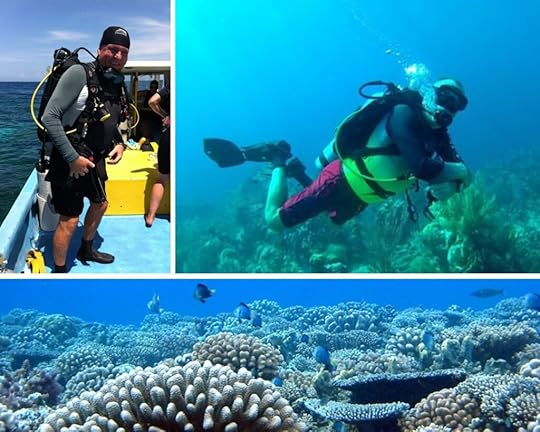 The Backpacking Husband diving Utila Honduras
The Backpacking Husband diving Utila HondurasDive Training on Utila: There are over a dozen dive centres on Utila – all on the main street and so working your way up to higher levels of scuba diver training with PADI (Professional Association of Diving Instructors) or SSI (Scuba Schools International) Certifications and Qualifications is possible here on Utila at the most affordable prices.
The Caribbean Sea: is crystal clear and as warm as bath water and of course it’s all around the island! The sea here has shallow coral reefs teeming with colourful tropical fish, rays, sharks, and turtles and you don’t need to be a scuba diver to see this amazingly beautiful sea life as floating, snorkelling, or even freediving, is just as popular a pastime.
I have personally swam with dolphins, eagle rays, sting rays, and pilot whales – and the largest fish in the sea, the whale shark!
 The backpacking husband swimming with a whale shark off Utila. Photo: Dave ThatcherTravel Guide To Utila Honduras
The backpacking husband swimming with a whale shark off Utila. Photo: Dave ThatcherTravel Guide To Utila HondurasShopping: There are no chain stores and there’s no McDonalds to be found here. Instead, there’s small roadside shacks with thriving local grocery businesses offering fresh fruit and vegetables and other island supplies that come onto the island from the mainland twice a week by boat. There are also a few souvenir shops and local artists selling art.
I like to buy mangos off street traders and to shop in the local shops but I buy fresh fish straight from Zorro the fisherman.
 Supplies come onto the island from the mainland twice a week by boat.
Supplies come onto the island from the mainland twice a week by boat. I buy fresh fish straight from Zorro the fisherman.
I buy fresh fish straight from Zorro the fisherman.Restaurants and Bars: Dockside restaurants and bars serving delicious local and international cuisine with a rum cocktail or a beer are plentiful on Utila. Many are located on wooden docks over the water to offer a sea breeze as a relief from the tropical heat and associated biting flies and mosquitoes.
You might consult Utila Guide or the 10 Best Restaurants on Utila in 2022 on Trip Advisor.
Our personal favourite sun set watching and cocktail enjoying spot is at Mango Tango Restaurant, which provides a sophisticated ambiance and truly fabulous fine dining experience on the island.
For an afternoon tea or evening tea infused cocktail The Tea Garden is a fabulous and new addition to the island scene in Sandy Bay offering specialist and traditional tea beverages in quintessentially vintage china and in a gorgeous and tranquil tropical garden setting. Iced Earl Grey anyone? Yes, please!
Another notable restaurant on the island in a beautiful and atmospheric tropical garden setting is El Castillo Caribbean Restaurant serving fresh home produced food in an intimate and romantic setting.
Beaches: Most days on Utila are hot and sunny and the beaches all have palm trees and white sand. You can choose to spend your days lazing on the beautiful curved beach at Bando Beach or at the public beach at Chepes or to take a boat through the lagoon and through the mangroves to reach the beautiful white sand of Coral Beach and Neptune’s Bar and Grill.
 Coral Beach on Utila
Coral Beach on Utila Beach walk… the Backpacking Husband on Bando Beach UtilaTravel Guide To Utila HondurasI HEART UTILA
Beach walk… the Backpacking Husband on Bando Beach UtilaTravel Guide To Utila HondurasI HEART UTILA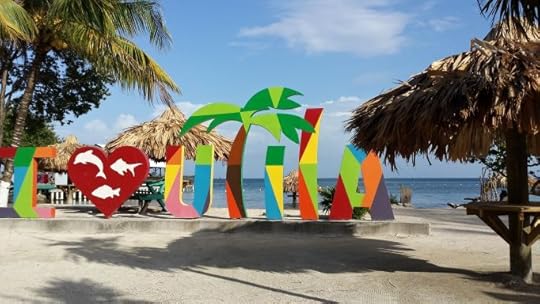 I Heart Utila
I Heart UtilaI love to go to bed early and wake at sunrise. I love to spend time with friends at the beach and/or at restaurants and bars. I love to spent hours reading in a hammock. I love to sunbathe and then swim in the sea every day. I walk everywhere and that way I get to speak to all the people whom I meet along the route into town or to the beach. I love to fully embrace this island life by truly living in the moment. I love to watch the sun go down every night in paradise and for that I am truly thankful.
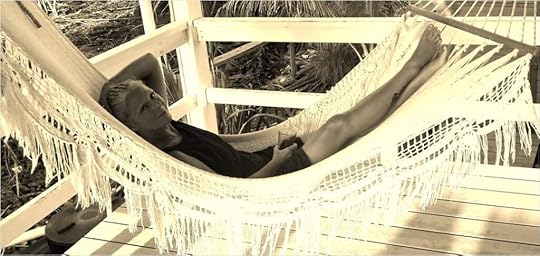 I love to spent hours in a hammock. WHERE TO STAY ON UTILA
I love to spent hours in a hammock. WHERE TO STAY ON UTILAThere are lots of accommodation options and for all budgets on Utila. There are so many rooms to rent, small apartments, beach houses, beach shacks, backpacker hostels, and accommodation rooms that come as part of the package with dive courses. You can find them all advertised on Airbnb or other accommodation booking sites and also on the Utila Guide Website or various member Facebook Groups that are linked to Utila with lots of useful information on Utila.
We rent a little Caribbean style house under a mango tree that’s close to town. It’s comfortable and beautiful. It’s the same house that we’ve rented a couple of times before. This time, as soon as I knew we were planning our return to the island for six months, I contacted our friend and landlady to secure the property again for our visit this year.
UTILA CAYSSometimes, we’ll go out on boats with friends to visit the neighbouring island ‘Cays’. The Cays are a scattering of tiny tropical islands off Utila. The Utila Cays are privately owned islands and some have a luxury and private residential home built on them and are not currently available to visit or rent. Others are ‘rentable’ by the day or the night.
We love to take a charter boat and spend a whole day on Water Cay or even a few days and nights on the other private rentable islands of Little Cay and Sandy Cay.
Pigeon Cay. Along the way, we’ll be sure to stop off at the larger municipal island of Pigeon Cay, an island filled with a tight-knit community of local people’s homes and fishing businesses, to buy some fresh fish to barbeque for lunch or dinner.
Jewel Cay. Stop for lunch at Jewel Cay – I recommend the Fisherman’s Plate.
Water Cay is a popular island day trip from Utila and a wonderful place to spend a beach day.
Little Cay: is a private island off Utila that you can arrange to rent with accommodation. The one large house sleeps around ten people with five bedrooms. When our family came out to visit us, we rented Little Cay and had a whole tropical island all to ourselves for several days.
Renting these tiny islands is a real and affordable option and a very special desert island ‘castaway’ experience. I mean, where else in the world can you rent a private island so inexpensively?
Sandy Cay: This year we’ve already reserved Sandy Cay – another private island getaway – for three nights during August. There’ll be just the six of us (the house has three bedrooms) for three nights and we’ll spit the $175 price per night between us on this tiny island paradise!
Note: prices current at the time of writing.
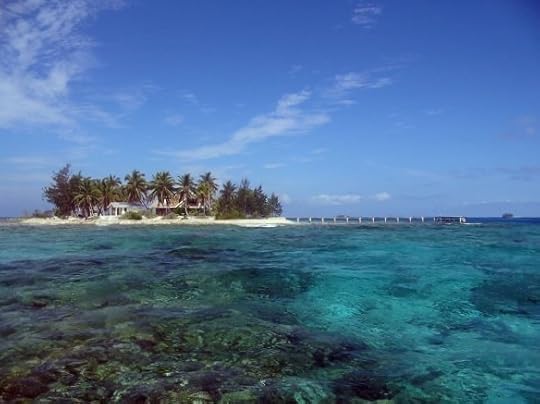 We rented the private island of Little Cay.MONEY
We rented the private island of Little Cay.MONEYMoney: The currency of Honduras is The Lempira. Some shops and restaurants will take credit/debit card payment but most don’t. You can use US Dollars here but they have to be in pristine condition and in $10 or $20. For Lempira cash withdrawals there is one bank on the main street and two ATM’s but in my experience they only work/ have cash in them for half the time.
HOW TO GET TO UTILAI’ll be honest with you and say that Utila is not the easiest island in the world to get to or indeed to get off again. It’s not too bad coming in from Canada (directly or via Mexico City) or from various cities in the USA but it’s a long haul to get here from the UK or Europe.
I remember the first time we came here; we flew from Glasgow Scotland via New York then via Miami onto Roatan (the larger of the Bay Islands). Finally, we took a tiny plane over to Utila because Utila has a small airstrip.
I’d never flown in a Cessna before and I remember being terrified and exhilarated in equal measures.
 Heading to Utila for the first time in a Cessna was both exhilarating and terrifying!
Heading to Utila for the first time in a Cessna was both exhilarating and terrifying!On other trips and this time, we took four flights. First, we flew from Glasgow to London with British Airways. Then, London to Houston Texas with United . From Texas we flew to San Pedro Sula Honduras with United and then from San Pedro Sula over to Utila with CM Air and all the time I noticed the planes were getting smaller and smaller!
So, it’s entirely your choice whether to fly from your origin point into San Pedro Sula and then make your way to the island directly by air or via road transport to the port La Ceiba and then to take the Utila Dream ferry.
Alternatively, fly into Roatan’s International Airport (on the larger of the Bay Islands) and then take a short flight or the Utila Dream ferry from Roatan over to Utila.
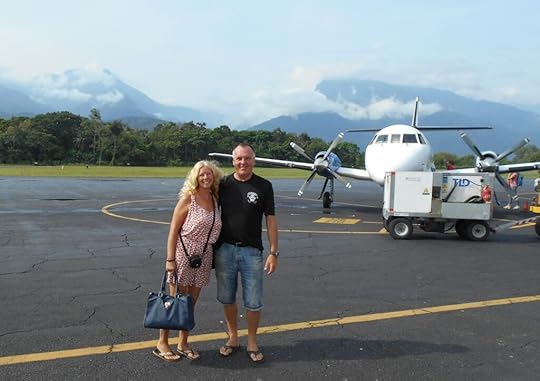 Another time… heading to Utila from San Pedro Sula HondurasTHERE IS NOWHERE IN THE WORLD LIKE UTILA
Another time… heading to Utila from San Pedro Sula HondurasTHERE IS NOWHERE IN THE WORLD LIKE UTILAWe immediately fell in love with this island and its people. We became intoxicated (sometimes quite literally as the rum is delicious) with the no news, no shoes, snoozing/reading in a hammock and never really knowing or caring what day it is, kind of island lifestyle. Drinking rum and cocktails and watching spectacular sunsets is a daily island spectacle starts at 6pm.
For yogis, yoga on the dock is available to all at sunrise and sunset.
During our world travels the backpacking husband have now been around the whole world twice and we’ve visited 39 countries (see my List of Travel Destinations) and so I suppose I’ve always expected to find another island something like Utila somewhere else in the world.
Maybe amongst the islands of the Seychelles or those tiny islands in the Sulu Sea between the Philippines and Malaysia?
Or perhaps off Thailand amidst those verdant jewels in the Gulf of Thailand or on the Andaman Sea.
And, if not there, then surely somewhere beyond Bali in Indonesia?
But no…. from what I can see there is no other place like it.
 This must be the place….CHANGES ON UTILA?
This must be the place….CHANGES ON UTILA?It’s been four years since we were last here on the island and so we expected to see some changes, especially since the pandemic. These days, there is a new touristy ‘I Heart Utila’ sign and an oversized beach chair and a huge Instagramable ‘picture frame’ on Chepes beach that looks to be very popular for those essential ‘Insta’ holiday beach shots.
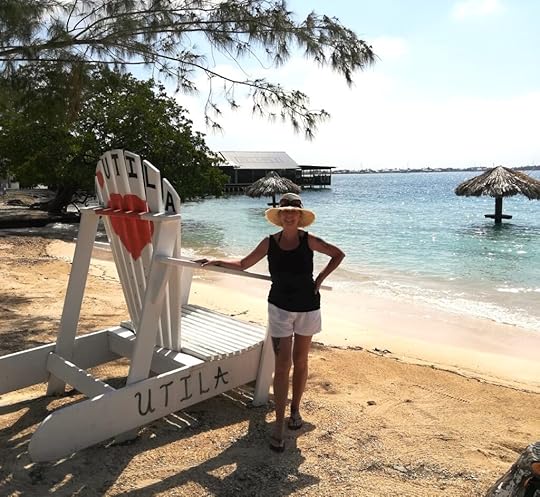 The BIG beach chair on Chepes Beach Utila
The BIG beach chair on Chepes Beach UtilaI see there are several more local grocery stores and that our own favourite store on the island has moved 200 yards down the street to occupy a slightly larger space. That’s great progress for our shopkeeper friend, Wardy, from whom we like to buy our fruit and vegetables. But you should also know that wherever you choose to shop on the island you have to be quick to buy what you need as the supply boat only comes in twice a week on a Tuesday and a Friday!
Our favourite dive shop Gunter’s Ecomarine Dive Centre changed hands last time we were here four years ago. This change, for us and for our Ecomarine family, felt like the end of an iconic era.
We were ‘The Ecomarines’ and our mantra was ‘Freedom Rules’ (I have the T-shirt!). Right now though, sadly, our beloved Gunter’s Ecomarine Dive Shop, the very first dive centre on Utila, is unmanaged and closed down.
I’m not normally one to resist change and so I just feel incredibly privileged to have known Ecomarine Dive Shop back then, and to have been here during what was for us ‘the golden years’ when life on the dock was especially sweet.
When days were spent out on the ‘Salva Vida’ dive boat or on Ecomarine dock hanging out with friends or spent reading in a hammock or taking a swim in the warm sea or even taking turns to grab and swing the fun rope swing.
The sultry evenings at Gunter’s Ecomarine were filled with open air movie nights, beers, rum, BBQ, fish fries, parties, music and dancing. It was all so incredibly special. Gunter himself is also special – he’s a much loved personality who set up the first dive centre on Utila and so he has a long diving history on the island – and I do love to see him riding along the street on his bicycle with an air tank strapped on his back when he’s heading out diving!
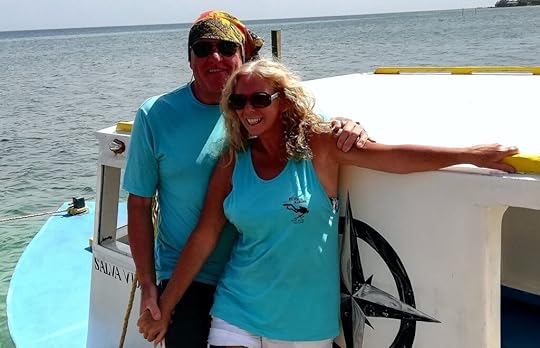 We were ‘Ecomarines’ and our mantra was ‘Freedom Rules’ (we have the T-shirt!).Scuba Diving on Utila
We were ‘Ecomarines’ and our mantra was ‘Freedom Rules’ (we have the T-shirt!).Scuba Diving on UtilaThis year, the Backpacking Husband has found a brand new dive shop at Tank’d Pro Dive Centre at Odyssey Resort on Utila.
 This year the Backpacking Husband has found a brand new dive shop at Tank’d.
This year the Backpacking Husband has found a brand new dive shop at Tank’d.There are famously over a dozen dive centres on Utila and they are all on the main street. Tank’d Pro Dive Shop is at the top end of the street almost at The Point and is affiliated with SSI. It’s a new and friendly dive centre with a brand new dive boat and top-end new dive equipment. It’s a great set up for divers both new, novice, experienced, and of all age groups.
Tank’d is run by friendly and professional people. There is also accommodation on site, a bar, and a restaurant. We would recommend you check out Tank’d Pro Dive Centre if you are looking to dive with a new professional dive shop on Utila.
Utila… Then and NowTraffic On The Island: Until fairly recently, there were no cars on the island of Utila and traffic was just a few bicycles, motor scooters, electric golf carts and, of course, lots of speedy little taxi tuktuks. These days, however, residential areas have expanded outwards and into the inner island and to other costal areas and so traffic noise and pollution has increased.
Shock – I’ve even seen a couple of small cars!
More and more people – even school kids – are now using scooters and motorbikes to get around instead of walking or cycling. Those that live further out and have to take the roughly surfaced roads into town are favouring off-road quadbikes.
All this ‘progress’ makes walking down the street for pedestrians, hazardous, noisy, and smelly, and a little bit dangerous.
Real Estate Developments on Utila: There are many new properties being built on the island, especially on the beachfront areas at The Point and Tradewinds, on South Shore and at Pumpkin Hill. The new properties all look very lovely – a dream Caribbean home for those building them – but I can’t help but wonder how eventually the infrastructure of such a small island will manage in the long term with such an influx of new residents.
Water: Fresh water is always going to be an important commodity on a tropical island. It is a matter of concern to islanders that the rainy season is becoming shorter each year. You cannot drink the tap water here and so several methods of water purification are used on the island and there are two companies providing and selling safe drinking water to the population.
But of course, many local people and especially those in the poorer community, are reliant on drinking filtered spring and well water, which is now becoming increasingly polluted with incoming seawater.
Refuse: Rubbish is an issue here and dumping is a problem. Despite some progress and expansion of the population, the island struggles to deal with garbage and burning landfill is a serious issue here.
Electricity is becoming increasingly expensive here. Utila is said to have the highest electricity charges by the KW in the entire world! Isn’t that crazy in what might be considered to be a developing country? The island is powered by a private company using diesel generators and power outages (although fewer than I remember from the very first time we were here) are still unavoidable and regular occurrences. The power shuts down sometimes for scheduled maintenance and sometimes because of a fault, a fire, or just a usage overload.
Power outages are not too much of a problem or an inconvenience on the island in the daytime, when you can perhaps escape to a breezy dock or take a swim in the sea to cool down, but a power outage at night is, in my own experience, very uncomfortable in such a hot and humid and tropical place. Sundown is at 6pm and then no one has any lights other than candles and torches and more importantly, access to a fan or air conditioning.
Internet: Generally, the internet is good on the island, but because the electric power is unreliable that also means of course that internet access can also be sporadic. Perhaps Utila isn’t the best place to be a ‘digital nomad’ but there are indeed people who work online here successfully and whom I believe manage to overcome this issue using various devices they have brought in to help facilitate a more reliable independent connection.
Heat: Did I mention the blistering heat and incredible humidity at least once already?
Wildlife: Much of Utila is actually mangrove swamp which is environmentally important. Huge swathes of it has been cut back and destroyed in the past but now there are efforts to conserve and replant. The Utila Iguana (Ctenosaura bakeri) also known as The Utila Swamper is the unofficial mascot of Utila and there are ongoing efforts to conserve it.
On the beaches the sand flies are an irritation here – see my post on coping with sand flies and no’see’ums – and mosquitoes are also troublesome. Scorpions, snakes, tarantula spiders, large iguanas, are harmless but scary creatures but there’s nothing on Utila that’s venomous, thankfully. These days, I’ve even become a calm and gentle dab-hand at removing large hairy tarantula spiders from the house and putting them ‘out to play’ with their friends rather than having a screaming fit like the first time I saw one crawling across my bed here on Utila. Here, the tarantula is your friend!
You can kind find out more about the indigenous wildlife at Kanahau Wildlife Conservation on Utila.
Noise: It has to be said that in my experience Utila is a paradise but it is often a noisy island. Barking dogs, crowing cockerels, and reggae music is often loud, relentless, and disruptive. Except for the Cays, I’ve yet to find a quiet place anywhere on Utila!
Travel Guide to Utila HondurasWHEN IS THE BEST TIME TO VISIT UTILAThe best time to come to Utila depends on the main reason for your visit. There are only two seasons in this part of the world and that’s high summer season and low rainy season.
Whale Sharks: If like lots of people you come to Utila to swim with whale sharks, the biggest fish in the sea, who famously migrate through the waters here throughout the year but typically in March – April – May and in August – Sept – Oct then visiting during those summer months will give the best chance to see a whale shark during your stay.
Summer High Season: the summer starts on Utila in March (tail end of Rainy Season) and lasts through to the end of September when the weather is increasingly hot, dry, and still, mostly because the east wind stops providing its welcome cooling effect across the island.
I’ll be honest with you, we’ve often been on the island during August and September and the temperatures can be punishingly hot, humid, sweaty, and utterly stifling. Not for the faint hearted!
Low Rainy Season: From early October through to the end of February is the low and rainy season on Utila. It doesn’t rain the whole time, of course, but the humid air is cooler and the bugs / mosquitoes can be so bad and so I would personally suggest coming at a different time.
That said, many local residents say they love rainy season, as they can get things done during the cooler months that in the intense heat of the summer would be very difficult indeed .
Temperatures: Daytime temperatures on Utila in the Summer are fairly consistent and usually range in the mid 80s Fahrenheit and mid 30s degrees Celsius but do be warned that in the high humidity here the ‘real feel’ temperatures are MUCH higher and so a seemingly managable 34 deg C WILL feel like a blistering sunstroke inducing 40 deg C!
As a tip: I so recommend you top up your electrolytes every day here to stay hydrated.
Sea Temperatures: The sea is pretty fabulous and consistent 27 – 29 deg C here in the summer months so only slightly cooler than the air but that makes for fabulous swimming!
Hurricane Season: Hurricanes are rare on Utila because The Bay Islands are considered to be below the ‘hurricane belt’ but they can happen on occasion. See my post entitled ‘There’s A Hurricane Coming!‘ on preparing for a hurricane on Utila. The official hurricane season is from June to the end of November but the majority of storm activity in this westerly area of the Caribbean area is usually confined to mid-September to the end of November.
Highdays and HolidaysThe island of Utila hosts several festivals throughout the year and this is when the island gets very busy indeed with fun-loving international tourists and holidaying Honduran people from the mainland (only 20 miles away). It’s probably because of these festivals at certain times of the summer that Utila has gained a reputation as a ‘party island’.
The first of these festivals is Semana Santa or ‘Holy Week’ which is always celebrated during the week coming up to Easter. The island is always incredibly crowded and busy during this time and accommodation on the island should always be booked in advance to avoid disappointment and having to sleep on the beach with the sand flies.
Utila Carnival: Utila carnival is such a fun celebration. The streets are decorated with flags and tickertape and many of the dive centres and businesses on the island decorate tuktuks and golf carts and trailers to enter into the themed floats street parade.
From the carnival floats, bead necklaces and sweet candies are thrown into the cheering crowds that line the street.
The passing parade is often accompanied by people dressed up as Pirates of the Caribbean or just in colourful fancy dress.
Carnival day on Utila is always a spectacular day on the island!
 Utila Carnival is always a spectacular day!
Utila Carnival is always a spectacular day!Music Festivals: The island or a neighbouring ‘cay’ often host music festivals in the summer months and of those ‘Utila Live’ and ‘Beyond’ and the famous ‘Sunjam Music Festival’ is probably the most popular. And – whether it’s electronic, house, rap, reggae, or classic rock music – the island is literally rocking during these festivals and there is no getting away from the sound!
I’ve happily attended many of these island music festivals myself and still have the programmes and the t-shirts!
 WHAT’S THE VERY BEST THING ABOUT UTILA?
WHAT’S THE VERY BEST THING ABOUT UTILA?In my opinion… it’s the friendly people.
It’s our lovely friends on the island who remember us and welcome us back.
 With Our Utila Family at Water Cay
With Our Utila Family at Water CaySO, I GUESS WE COULD BE STAYING A WHILE!
Where in the world is your special and secret place?
Have you ever been to Utila or the Bay Islands?
Do share in the comments or get in touch via my social media!
The post Travel Guide to Utila Honduras appeared first on The Backpacking Housewife.
February 6, 2022
Best of Hoi An – Vietnam
The Vietnamese town of Hoi An has an enchanting and well-preserved ancient ambience that offers the visitor the best of Hoi An Vietnam and a window into the centuries past in which Hoi An was an important Asian trading post.
It’s a witness to 800 years of celebrated history and that history is still evident today in its original wooden buildings and old bridges that span its river and outlying canals.
Its this atmospheric feeling of stepping back in time in Hoi An that attracts so many visitors from all over the world.
Hoi An old town spans the slow-moving Thu Bon River on which simple wooden boats take tourists on romantic river cruises where lanterns float at sunset. Ornate bridges across the river offer the visitor fabulous spots from which to take photographs.

In the centre of town is the world famous covered Japanese bridge was first constructed in the 1590s.
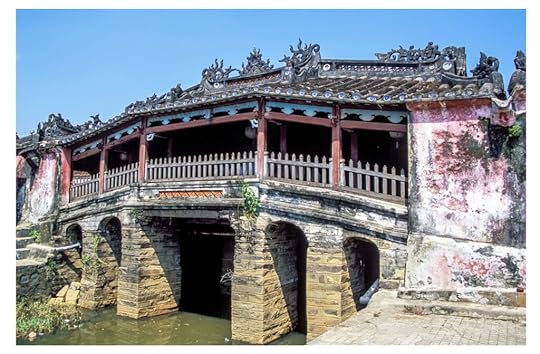
An ‘old town ticket’ is required to explore some of the UNESCO sites and to cross the Japanese Bridge.
The town of Hoi An is compact and its a great benefit that motorised transport is prohibited for several hours of the day because this makes walking around or taking a ‘cyclo’ or ‘cycle rickshaw’ a real pleasure through the narrow streets.


 The Backpacking Housewife in Hoi An Vietnam
The Backpacking Housewife in Hoi An VietnamI was amazed to see the amount of tailor shops in Hoi An – there are several in every street – and the incredible talent of the local tailors and seamstresses is evident everywhere with beautifully created clothes – all personally made to measure – for sale at incredibly affordable prices.
Lots of people come to Hoi An specifically to have new clothes made to measure.
We saw brides, grooms, and bridesmaids all being measured up. One lady I met had brought several of her favourite (designer) dresses with her to Hoi An to be faithfully replicated in other fabrics and colours. When the backpacking husband and I discovered that our hotelier at Moon Villa in Hoi An – a lovely lady actually called Moon – was also a tailor and had a shop on the premises, we browsed her intricate work and the fabulous fabrics on offer in the finest cottons, linens and silks.
And, we soon asked to be measured up for some new shirts, trousers, and a new dress for me.
 Moon at Moon Villa Tailor Shop Hoi An Vietnam
Moon at Moon Villa Tailor Shop Hoi An VietnamOur hotel experience in Hoi An was absolutely fabulous and so I would heartily recommend Moon Villa to you.
The rooms at Moon Villa are lovely and have aircon and there’s also a small swimming pool, which I have to tell you I was desperate to get back to everyday, after venturing out in the Vietnamese heat. And, the weather in Vietnam and the intense heat and humidity in the summertime was like nothing I’d ever experienced before!
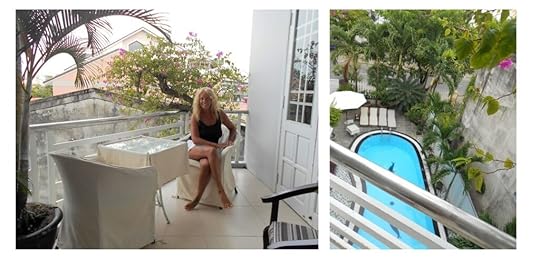 The Backpacking Housewife at Moon Villa Hoi An
The Backpacking Housewife at Moon Villa Hoi AnAside from the historic sights of Hoi An, the bars and restaurants are plentiful, and they all offer pretty and restful viewing spots on the street or from balconies. One of my favourite spots, especially when feeling beaten by the incredible heat and humidity, was in the heart of the old town at the White Marble Bar, where we often whiled away the afternoon sipping lychee martinis and watching the local people passing us by on bicycles or the tourists sitting in the carts of the iconic ‘cyclo rickshaws’.
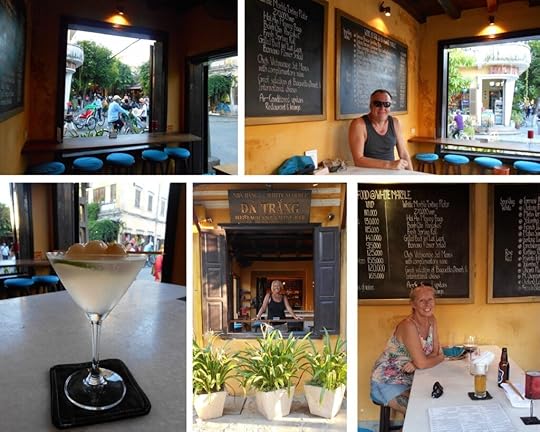 The White Marble Bar Hoi An Old Town
The White Marble Bar Hoi An Old TownAs the sun goes down on Hoi An and in the evening, the heat becomes more sultry and the sights even more stunning.

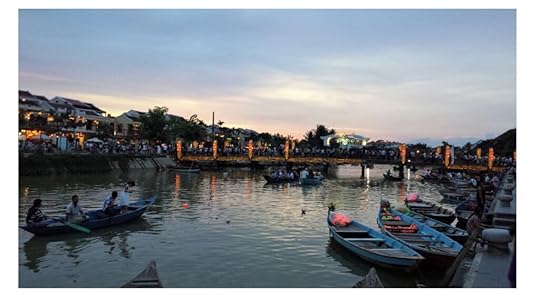

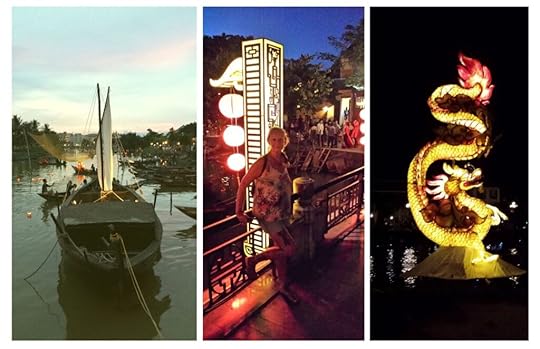
There are fairy lights and colourful lanterns lit everywhere and the effect is quite magical, especially on the river and the riverbank where the lights of the bridge and the boats and lanterns and candles are reflected all around. Beautiful!
We spent a whole month in Vietnam and we flew from Singapore into Da Nang airport. Da Nang is Vietnams third largest city and it’s located on the eastern seaboard coast, geographically approximately halfway between Hanoi and Ho Chi Minh City.
And, when we first arrived, I had a writing deadline so we took the opportunity to relax for several days at a homestay hotel on the expansive beachfront area just outside Da Nang City at the popular An Bang Beach.
An Bang beach once featured on CNN’s ‘Top 100 Best Beaches in the World’.
An Bang is a vast and popular huge stretch of shimmering beach and the whole oceanside area is well set up for tourists with hotels, homestays, and bars with live music and open air restaurants.
So, as you might imagine, it is always busy and bustling and did I mention blisteringly hot?
Oh my goodness – the sand on An Bang beach was too hot to walk on without flipflops when we visited in August!
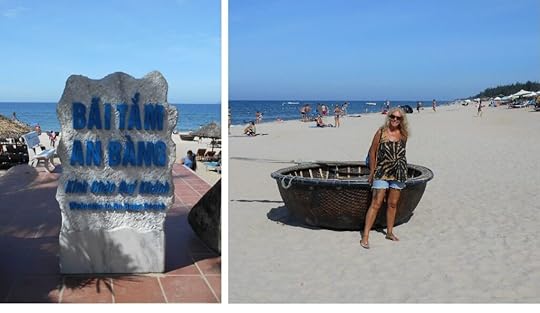
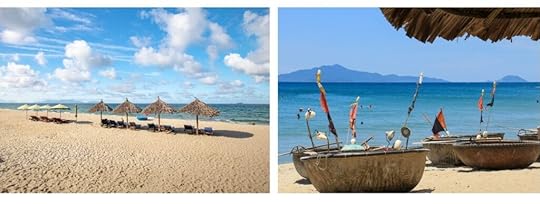
So, after a few days of sweltering in An Bang, we decided to move a few miles further up the coast to stay for a week at another beachside resort called Cua Dai, where we found a quiet and laid back beach with powder soft white sand.
Cua Dai beach was once known as one of the most beautiful beaches in Asia, until around 10 years ago when it began to suffer from severe erosion by strong waves and tropical storms due to global warming. The erosion causing Cua Dai beach to narrow is currently being countered by extensive anti-erosion works to try and save what is left of the beach and to stop more beach sand being shaved away by the elements.
Once an exclusive place favoured by the jet-set with its hi-class accommodations and fabulous seafood restaurants, we found Cua Dia to be a perfect, laid-back and quiet place, to really relax and rewind.
The fact that most people now favoured An Bang beach instead was absolutely to our benefit.
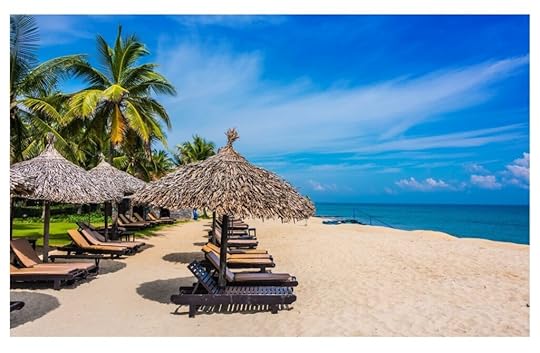 Cua Dai Beach
Cua Dai BeachIn Cua Dai, we stayed in another wonderful homestay right opposite the beach and we ate most of our evening meals on the edge of the sand at small restaurants and bistros serving fabulous seafood. Occasionally, we wandered into the village, past open air and palm thatched huts displaying local crafts and art, to find small family run restaurants that excelled in fabulous friendly service and delicious local food.
Flying into Da Nang Airport on the central Vietnam coastline offers access to some of the highlights and best experiences and sights of Vietnam and for me the experience of Hoi An will stay with me as one of the most special experiences of my life.
I do hope to return to Vietnam – as soon as post-pandemic travel allows – and next time, I’ll fly into Hanoi in the north and then travel through the whole country to eventually reach Ho Chi Minh City. What an adventure that would be!
Have you ever travelled to Vietnam?
Where did you stay and what did you explore and experience?
Let me know. I’d love to hear from you!
Leave a comment or contact me directly though my Contact Me Page.
The post Best of Hoi An – Vietnam appeared first on The Backpacking Housewife.
February 3, 2022
Explore Singapore
To me, Singapore has always seemed to be a mythically enchanted place in an exotic and faraway land that my much younger and untravelled self has always dreamed of exploring. Since then (and pre-pandemic) I’ve been fortunate to explore Singapore several times and I’ve found the exotic enchantment to be not mythical but enticingly real.
My visits have sometimes been a mere stopover in beautiful Changi Airport before flying onto Kuala Lumpur Malaysia or Bangkok Thailand or South Korea or the grand elsewhere in Asia.
But sometimes, I’ve had the opportunity to linger a little longer and to savour and explore Singapore for a few days, during which time I’ve packed in many of the spectacular sights of Singapore both historical and modern and fun and interesting.
Therefore, this post is not a fact-file of travel information or a tourist’s itinerary that you could easily source elsewhere on the internet with a quick search, but rather my own personal account of experiences and of sightseeing adventures while exploring in Singapore with a sprinkling of travel tips that might guide and help you to prioritise your own time spent in this diamond shaped jewel of an island city located at the very southern tip of the Malaysian Peninsula.
 EXPERIENCE SINGAPORE
EXPERIENCE SINGAPOREWhat’s in the name? Singapore’s name is derived from ‘SingaPura’ which means ‘Lion City’.
Singapore has so many attributes to offer the visitor that it’s hard to know where to start and when to finish and so maybe this personal guide will help you with that?
There’s a rich and fascinating history from the splendour and elegance of Raffles Hotel and other colonial buildings.
For foodies there’s world famously delicious food from hawker stalls or high-class restaurants.
There’s fabulous retail shopping in Orchard Road. Food and local shopping in Little India and China Town.
Adventure and fun in spades can be found at Sentosa Island and Universal Studios Singapore.
And there’s captivating culture and amazing history in the museums and art galleries and modern architecture at Marina Bay Sands and The Gardens By The Bay. And, before you even get to all of that, the airport itself is so fabulous that it has been voted The World’s Best Airport eight times.
JEWEL CHANGI AIRPORTChangi Airport: Unless you arrive into the harbour by sea, or enter the island of Singapore by road or rail from Peninsular Malaysia via bridges over the narrow channel known as The Johor Strait, your first experience of Singapore will undoubtably be the amazingly ornate and beautiful Jewel Changi Airport.
 The worlds tallest indoor waterfall at Changi Airport Singapore
The worlds tallest indoor waterfall at Changi Airport SingaporeThe incredible rain vortex pouring from the dome shaped roof of Changi Airport is the worlds tallest indoor waterfall.
The airport is known as a destination in itself and as a place where ‘nature meets retail’.
Our first time in Singapore we stayed at The Holiday Inn Express as we are avid collectors of IHG Loyalty Points (not an affiliated link). We checked in for two nights and using our previously accumulated points we managed to get one of those nights free. Our first point of call after that was to enjoy a meal in Singapore.
THE SINGAPORE FOOD SCENESingapore is famous for its food. The cuisine is a meld of Malaysian, Indonesian, Chinese, and Indian flavours. Singapore is also famous for its seafood. Authentic Singaporean food includes its signature and national dish ‘Chilli Crab’ with spicy tomato chilli and black pepper. For fabulous food explore Little India, China Town, and Hawker Food Stalls that serve ‘street food’.
 Singapore cuisine is a meld of Malaysian, Indonesian, Chinese, and Indian flavours.RAFFLES HOTEL
Singapore cuisine is a meld of Malaysian, Indonesian, Chinese, and Indian flavours.RAFFLES HOTELRaffles Hotel: Raffles Singapore is named after Sir Thomas Stamford Raffles, the founder of Singapore, and opened on the 1st December 1887 as a ten room hotel by the Sarkies brothers. Raffles Hotel in Singapore is synonymous with elegance and luxury and has since been a haunt of adventures, movie stars, authors and journalists – and now The Backpacking Housewife!
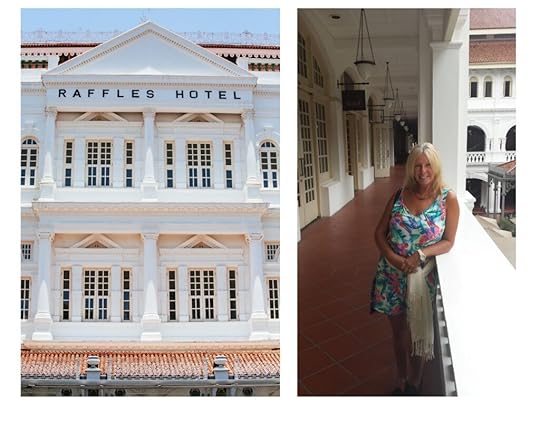 THE LONG BAR, CAD’S ALLEY, RAFFLES HOTEL
THE LONG BAR, CAD’S ALLEY, RAFFLES HOTELThirsty yet? Then let’s try a Singapore Sling at the Long Bar at Raffles Hotel!
The Long Bar at Raffles Hotel, located off Cad’s Alley, is the original home of the famous cocktail The Singapore Sling. It was created by Raffles bartender Ngiam Tong Boon in 1915 when the etiquette of the time prevented ladies from drinking alcohol in public. Insightful Ngiam made the beverage with clear alcohol and fruit juices to make it appear socially acceptable for women to drink alcohol covertly and the immediately popular Singapore Sling was born!


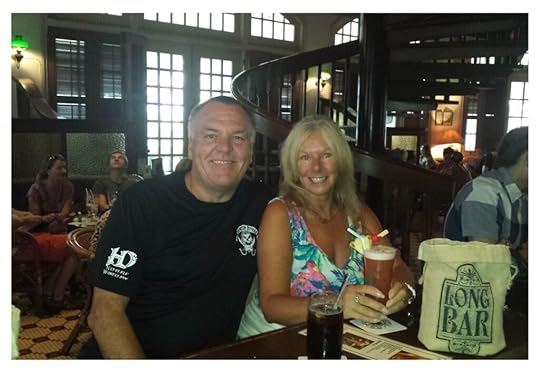
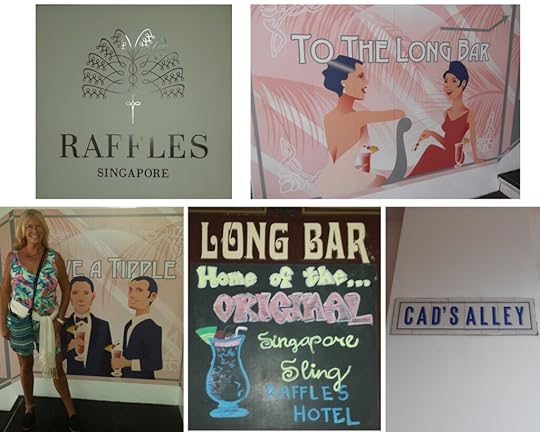
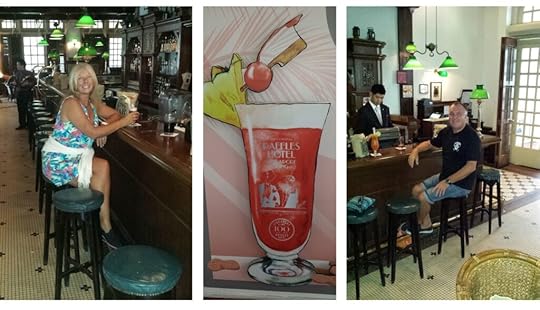 The Original Singapore Sling Recipe!
The Original Singapore Sling Recipe!30ml Gin
15ml Cherry Heering Liqueur
7.5ml DOM Benedictine
7.5ml Cointreau
120ml Sarawak Pineapple Juice
15ml Lime Juice
10ml Grenadine
A Dash of Angostura Bitters
Garnish with a Slice of Pineapple and a Cherry
SHOPPING IN SINGAPOREShopping: If you love shopping for high fashion and trinkets and souvenirs and you also love a bit of designer inspired retail therapy then you will undoubtable think you are in a shopping paradise in Singapore. Because I only carry a small backpack on my travels around the world, my forays into the shops are more of a window shopping and fun browsing venture – although I might on occasion treat myself to a new lipstick or perfume or small wearable trinket!

Orchard Road with its international stores, local boutiques, and mega malls at each end, is considered by many to be the best shopping in Singapore. Others will insist that title belongs to Marina Bay.
If your shopping budget (like mine) is far more conservative than designer then perhaps shopping in China Town’s fabulous market for authentic (and affordable) local produce might be more your bag.
 AMAZING THINGS TO DO IN SINGAPORE
AMAZING THINGS TO DO IN SINGAPOREGardens By The Bay: In the incredible Garden By The Bay you will find a Cloud Forest, a Flower Dome, and a Super Tree Observatory. In Super Tree Grove you can see a free Garden Rhapsody music and light show. There is so much to see and do here, in fact, that you’ll need to see and explore it all yourself to believed it!
Marina Bay Sands: Here you will discover shows and events and nightlife. This is where you’ll find the fabulous Marina Bay Sands Hotel – looking like a ship on the Singapore skyline – with its iconic architecture and infinity sky pool and Sky Park Observation Deck.
Sentosa Island and Universal Studios: There are over 30 totally incredible world class attractions on Sentosa Island including the Singapore Cable Car Network linking Mount Faber, Harbourfront and Sentosa Island.
And, in the heart of Resorts Word you’ll find Universal Studios Singapore!
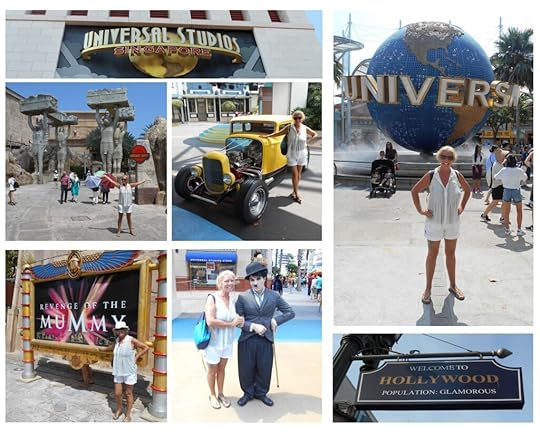 The Backpacking Housewife at Universal Studios Singapore
The Backpacking Housewife at Universal Studios SingaporeOn the official Singapore website it asks you to ‘reimagine’ when you explore Singapore and says: “with its century-old temples, bustling hawker centres and lush green spaces, Singapore’s varied charms are bound to enchant visitors to our island. Our city’s calendar of events is equally diverse, and present travellers with ample opportunities to explore, indulge and express their passions” – and I heartily agree!
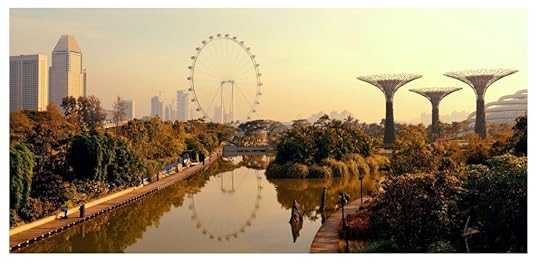 A LITTLE FURTHER AFIELD
A LITTLE FURTHER AFIELDOff the Singapore Strait and lying between the Malacca Strait, the Karimata Strait, and the South China Sea, is a group of 1,796 small islands known as the Riau-Lingga Archipelago that form a part of Indonesia. The three largest of these islands are Batam, Rempang, and Galang. And the reason I’m telling you about this is because, with a few days in which to be flexible, we decided to take a ferry from Singapore harbour – passing through Indonesian immigration – over to the island of Batam for a weekend stay at The Holiday Inn Resort Batam (not an affiliate link).

Our motive for this impromptu weekend break was actually part relaxation and part financial as there is no getting away from the fact that Singapore is an expensive city to explore and to enjoy and that neighbouring Indonesia is a very affordable option by comparison.
The Holiday Inn Resort at Batam Island is a tropical oasis with wonderful resort facilities including the fabulous and authentic Balinese Treetree Spa (where I had the best treatments and massage I’ve ever had in my life) and a beautiful swimming pool.
Just what we needed after our hectic few days spent exploring Singapore!
 A Few Interesting Facts About Singapore
A Few Interesting Facts About SingaporeTo the north, Singapore is separated from the Peninsular Malaysia by a narrow channel known as The Johor Strait. To the south is the Singapore Strait.
Singapore is also a hub as one of the largest maritime ports in one of the world’s busiest shipping lanes in the world as it is so well connected to over 120 countries.
In 1819, Sir Stamford Raffles – British statesman and official of the British East India Company – is perhaps best known for establishing modern Singapore. Raffles first landed in Singapore on 28th January 1819. He has a statue and a plaque to mark the spot which hails: “On this historic site, Sir Thomas Stamford Raffles first landed in Singapore on 28th January 1819, and with genius and perception changed the destiny of Singapore from an obscure fishing village to a great seaport and modern metropolis.”
“The Port of Singapore is a free port, and the trade thereof is open to ships and vessels of every nation, equally and alike to all.”
Sir Thomas Stamford Raffles
The currency of Singapore is the Singapore Dollar.
However long your stay and opportunity to explore Singapore do use the What To See And Do Calculator on the official Visit Singapore website. Simply tick the boxes of the kind of things that interest you and how many days you have available to explore Singapore and an itinerary will be instantly produced for you!
Have you ever explored Singapore?
Is Singapore on your travel wish list?
Let me know!
I’d love to hear from you so please leave a comment or ask a question if you have one. You can use my Contact form if you prefer straight through to my email and I promise to reply as soon as I can.
The post Explore Singapore appeared first on The Backpacking Housewife.
January 2, 2022
Island Hopping – Beyond Bali to The Gili Islands
Mention the island of Bali Indonesia or a Bali holiday to anyone and they will often sigh softly and go all misty eyed at the idea of travelling to this tropical paradise also known as ‘Island of the Gods’.
Indeed, Bali is a lush and spiritual place.
Bali lies in the western Lesser Sundra islands in Indonesia: east of Java and west of Lombok.
It is an island rich in natural beauty with a landscape that features a dramatic volcano, a natural rainforest, cultivated rice fields, and a coastline of beaches and swaying palm trees.
Lonely Planet calls it “a mood, an aspiration, a tropical state of mind.”
So, let’s explore Bali for a few days and then go island hopping beyond Bali and by boat to the tiny group of remote islands in the archipelago known as The Gili Islands.
 Bali… “a mood, an aspiration, a tropical state of mind“Bali Indonesia
Bali… “a mood, an aspiration, a tropical state of mind“Bali IndonesiaBali is somewhere I’ve always wanted to experience and explore but on this particular trip our arrival on Bali was just a planned three-night and two-day stopover before travelling onward and beyond Bali and by boat to the tiny group of more remote islands in an archipelago known as The Gili Islands just off the neighbouring island of Lombok.
We arrived in Bali on an Air Asia (no affiliate link) flight from Kuala Lumpur late one September evening (pre-pandemic) and my first impressions on arrival at Ngurah Rai Airport in the Bali capital of Denpasar, was that it was incredibly hot and humid and very busy.
I’d booked a hotel conveniently close to the airport for our first night’s accommodation, so that arriving after dark wouldn’t be an issue for us and we’d be well rested and ready to explore Bali first thing in the morning.
And I’m glad I did because the first thing that impressed me in the sharp morning sunlight was the huge modern and gleaming white mythical sculpture of gods and horses and chariots embroiled in battle that stands at the first road intersection just outside the airport.
It’s the Satria Gatot Kaca statue and it is truly breath-taking.
The magnificent statue, built in 1993 by Balinese artist I Wayan Winten, is a larger than life Balinese battle scene depicting Gatot Kaca, a courageous and powerful fabled flying knight, who is identified as being responsible for air defence and security protection for the Kingdom. The statue is therefore not only beautiful but believed to give spiritual protection to the airport.
 The Satria Gatot Kaca statueUbud Bali
The Satria Gatot Kaca statueUbud BaliWe were excited and in great anticipation of our first day on Bali because we were heading to the cultural and spiritual heart of the island to a place called Ubud. Ubud is also famous for its markets, restaurants, temples and its monkey forest.
As we only planned to spend one day and one night in Ubud, we wanted to make the most of every minute and opportunity. The owner of the homestay in Ubud where I’d booked accommodation via Booking.com (no affiliate link) had already been in touch with us to offer his services as a taxi. He’d offered to pick us up at our airport hotel and drive us back to his place in Ubud for a very reasonable price and we learned that happily this courtesy to guests is a common and much less-expensive way to travel from one place to another in Bali.
We drove for an hour past green and picturesque rice paddy fields and then trundled slowly through the stone carving village of Batubulan. Our friendly driver also acts as our guide and tells us that the name of Batubulan is derived from two words – Batu and Bulan – meaning moonstone.
I was fascinated to see so many art and craft workshops lining the main street.
Stone carving is important in Bali and the evidence of this is everywhere. But it really is amazing to see a whole village full of stone carving studios. Bali, it seems to me, is full of artist and art!
The streets are lined with statues and carvings for sale that range from small Ganesha and Buddha deities to devilishly scary looking Balinese mythical figures and life size rearing horses.
I had to wonder how tourists who buy these fabulous souvenirs actually get them home.
Some of the sculptures looked very old but our knowledgeable local driver explains to us that they are carved from ‘paras’ or volcanic ash, which is like pumice and actually much lighter than stone, and so soft that it manages to look old very quickly.
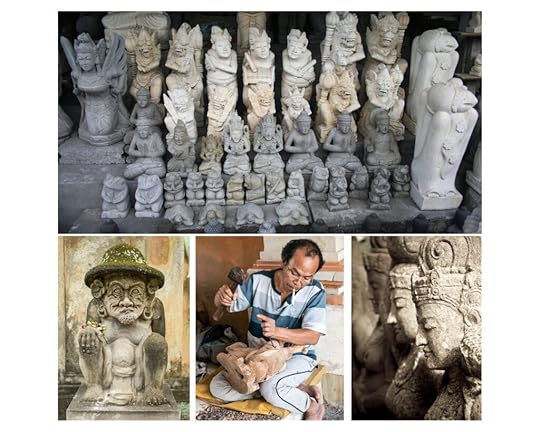 Stone carving is important in Bali
Stone carving is important in BaliWe soon arrived in Ubud and I was excited to see there were lots of monkeys everywhere but then Ubud is the famous home of The Sacred Monkey Forest! And rather than to stay in the forest, the monkeys obviously liked sitting casually at the side of the roads, sometimes alone and also in groups. They looked really cute all sitting in lines grooming each other and especially the tiny babies clinging onto their mothers.
There were many monkeys sitting in the middle of the road so that cars and cycles had to go around them.
Our driver pointed out a sign warning people to be cautious of the monkeys and to ‘watch your stuff’ because apparently the monkeys will steal from you and have a particular penchant for handbags and cameras.
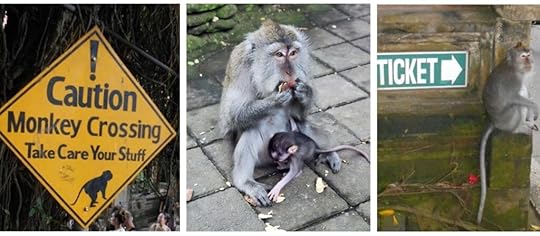 In Ubud and I was excited to see there were lots of monkeys everywhere!
In Ubud and I was excited to see there were lots of monkeys everywhere! We reached our homestay in town – Taman Ayu Ubud which was set in a really lovely garden accessed from the road through a narrow stone arched entrance gate. Our room was a beautiful and comfortable apartment with a private bathroom and an outside balcony but we were keen to free ourselves of our backpacks and head straight into town.
We walked the streets of Ubud in fascination at everything we saw and then we came across the market.
The market was colourful and noisy and crazy busy. I loved it – although not so much the hawkers selling cigarettes and pushing stuff in my face – but I took my time to browse the stalls selling fabulous trinkets and fabrics and spices and shoes and I treated myself a pair of beautiful sandals.
The backpacking husband absolutely hates crowds and he finds people pushing and waving stuff in his face beyond irritating. So at the market he trailed in my wake with his face set with misery!
 The market in Ubud was colourful and busy. I loved it. The Backpacking husband didn’t!
The market in Ubud was colourful and busy. I loved it. The Backpacking husband didn’t!After the market, deciding it was time for lunch, and we roamed the street looking for one particular restaurant that the backpacking husband was very keen indeed for us to try that had been highly recommended to us.
The restaurant we were looking for is world famous Ibu Oka Restaurant in Ubud.
It’s famous for it’s local food but also for Anthony Bourdain’s endorsement in his travel show ‘No Reservations’. The restaurant specialises in the Balinese culinary experience known as ‘Babi Guiling’ which is roasted suckling pig. You can get this traditional dish in lots of places on Bali but this particular restaurant is famous as a place of pilgrimage for lovers of roasted sucking pig.
Now, those who know me will know that I’m not normally a meat eater, but I do on occasion make an exception while I’m travelling the meal is of cultural significance.
It took us many wrong turns down narrow streets to find the restaurant and so when we did eventually stumble across it we were both convinced we’d found it purely by accident!
I have to say that it was curiously delicious meal incorporating crispy pork fat, spiced meat, and a blood sausage.
We decided it was well worth the effort to find the original and the most famous ‘Babi Guiling’ in Bali.
 At the world famous Ibu Oka Restaurant in Ubud
At the world famous Ibu Oka Restaurant in UbudNext, it was a sightseeing trip to The Sacred Monkey Forest, but we actually saw many monkeys along the way there.
I saw a monkey grab a bottle of water from the hand of a woman who was standing right next to me at a road junction. It then sat down in the middle of the road, unconcerned by the traffic whizzing around it, where it unscrewed the cap of the bottle and drank the water. What a cheeky but clever monkey!
The Sacred Monkey Forest is a leafy nutmeg and banyan tree forest and monkey sanctuary close to the town centre.
In the forest, there are many old temples and statues, all covered in moss and monkeys. It’s a beautiful and ancient looking place and it’s perfect for photo opportunities – but do heed the warning to beware – because many tourists report being ‘terrified’ ‘chased’ and ‘mugged’ by the monkeys!
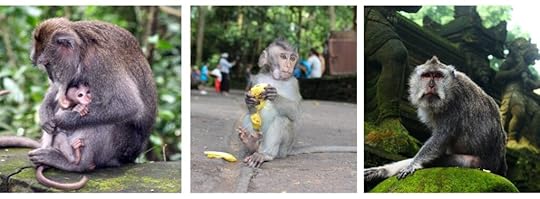 Many tourists report being ‘terrified’ ‘chased’ and ‘mugged’ by the monkeys!Kuta Bali
Many tourists report being ‘terrified’ ‘chased’ and ‘mugged’ by the monkeys!Kuta BaliThe next morning, our homestead owner drove us back towards the coast to Bali’s primary beach resort town, a place called Kuta. And, we had actually been prewarned, that it was reputedly the worst place in Bali.
Indeed, we found it to be a touristy and sleazy place, with fast food restaurants and a noisy stretch of beach packed with aggressive hawkers and swathes of tourists. We stayed at the H Sovereign Bali for the one night and took a walk along the beach road to get dinner from a well-known burger restaurant. We decided we couldn’t wait to leave Kuta.
 Kuta wasn’t quite the paradise we were looking for on this trip
Kuta wasn’t quite the paradise we were looking for on this tripNote: I’ve since been assured by travelling friends that there are many more beautiful and far more peaceful places on the island of Bali that we didn’t see or experience during our short stay. We have been told that we shouldn’t let our disappointment and impressions of Kuta overshadow the rest of what Bali has to offer. Places like Seminyak & Canggu and Munduk and, in particular the neighbouring islands of Nusa Ceningan, Nusa Penida and Nusa Lembongan.
So, I feel that perhaps we do need to go back again for another visit and to give Bali another chance.
I will admit that I was also particularly keen to leave from Kuta at Padang Bai ferry point because we were in great anticipation of travelling on to our ultimate destination in this trip: the Gili Islands from Bali.
Gili Islands Indonesia The Gili Islands Indonesia… paradise found
The Gili Islands Indonesia… paradise foundThe Gili’s are three picture perfect small tropical islands off the northwest coast of the larger neighbouring island to Bali called Lombok. There are no cars or motorised transport on these islands and they promise a simple laid back tropical island vibe.
In the local Sasak language, the word gili, means small island.
The three islands are called: Gili Trawangan, (known as Gili T) Gilli Meno and Gili Air.
We researched our sea crossing to the Gili Islands and booked with Blue Water Express (no affiliate link). There are many fast boats and slow boats to take you from Bali to the islands. I highly recommend you do a bit of online research before you make your choice of sea transport, as there have been many incidents of sinking, near sinking, capsizing, on board blasts and explosions that have resulted in tourist fatalities. So don’t just go for the cheapest boat tickets.
The ferry stops as Gili T first, Having done my prior research on the islands, we’d planned not to stay on the larger and livelier of these three islands, as Gili T is often described as a ‘party island’ and as we’d had our fill of hedonistic party islands in Thailand – on this occasion at least – we were looking for a more tranquil and laid-back vibe.
 The ferry first stops at Gili Trawangan (known as Gili T)
The ferry first stops at Gili Trawangan (known as Gili T) We were looking for quiet, relaxation, diving, snorkelling, great seafood, and a beach bar with a laid back ambience.
So we stayed on the ferry boat and we went onto Gili Air.
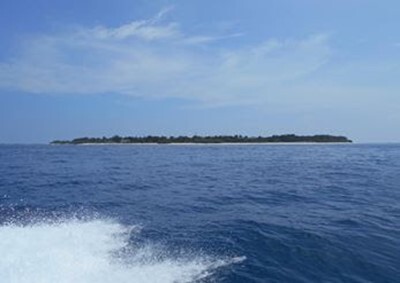 Gili Air
Gili AirOn arrival at Gili Air, pony and trap taxi’s were waiting on the sandy path main street to take us to our lodgings
 There are no cars or motorised transport on the Gili Islands
There are no cars or motorised transport on the Gili IslandsWe had booked for five nights on Gili Air at Anugrah Bungalow, a clean and basic homestay accommodation in a small garden villa. We were delighted with our bungalow. It looked comfortable and clean and we had a nice bedroom and separate private bathroom and we thought it very inexpensive at around £100 for the entire five nights.
 Our room on Gili Air : Main Street : The Beach
Our room on Gili Air : Main Street : The BeachOn our first day, we walked slowly around the whole island, which took us around ninety minutes while gazing out at the clear turquoise sea and the neighbouring islands on either side of us. Then, as we were heading down the sandy track of main street again – feeling thirsty and lured by all the bar signs to buy a cold beer – we headed to a beach bar.

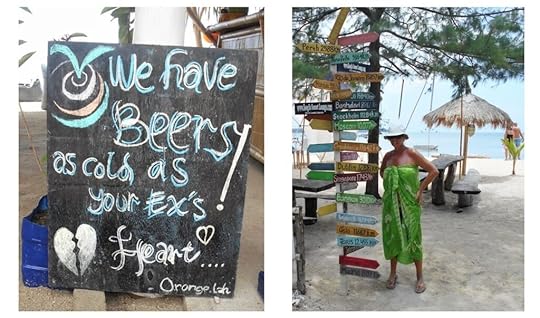 Feeling lured by all the bar signs to buy a cold beer!
Feeling lured by all the bar signs to buy a cold beer!Just when we were thinking we were just about as far away from anywhere as one could possibly be here on these tiny islands in the Indian Ocean where it meets the Pacific by the Wallace Line – we suddenly recognised two familiar faces coming down the beach – and we could hardly believe that two very good friends we’d first met in Thailand were also here in the island!
Our friends told us they’ve been travelling in Malaysia and Indonesia following the F1 Grand Prix and were now taking some time out to spend a few days on Gili Air. What an amazingly small world it is when you meet people totally by chance like that!
It was so great to see Rebecca and Mark again and happily we got to spend the next few days in their lovely company.
We enjoyed some lazy days and some really fun evenings together on Gili Air.
 We enjoyed some really fun evenings with our friends on Gili Air!
We enjoyed some really fun evenings with our friends on Gili Air!We also all went out on a dive boat together too with Manta Divers.
As a non- diver myself, I went snorkelling off the boat, while the backpacking husband and friends went scuba diving.
 We went out on a dive boat together with Manta Divers on Gili Air.
We went out on a dive boat together with Manta Divers on Gili Air. Then, after five wonderful days and nights on Gili Air, the backpacking husband and I bade farewell to our friends and hopped back onto the ferry heading across the sea to the next island hopping adventure on the neighbouring island of Gili Meno.
 Gili Meno
Gili MenoGili Meno is an even smaller and even more laid back island than Gili Air.
Gili Meno is often described as ‘Robinson Crusoe Island’ as it certainly looks like a castaway’s paradise with white sand beaches, coconut palms, clear warm waters and lots of peace and quiet. Below is my photo of the harbour area. Idyllic!
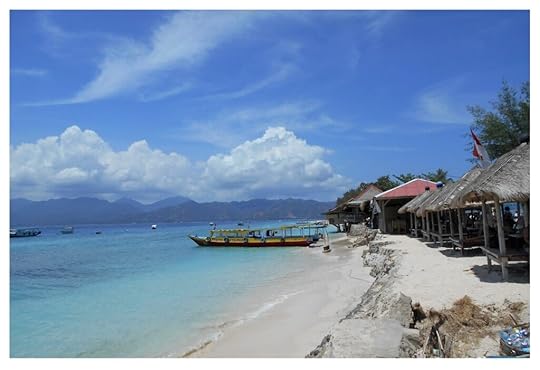 My photo of the harbour on Gili Meno
My photo of the harbour on Gili MenoAgain, there are no cars or any motorised transport on the island and the best way to get around is by walking along the sand tracks or taking a pony and trap taxi ride.
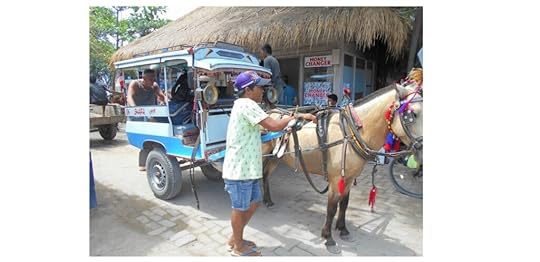 Our pony and trap taxi on Gili Air
Our pony and trap taxi on Gili AirWe planned to stay on Gili Meno for five nights at Kebun Kupu Kupu Eco Resort. Our accommodation was situated inland amongst a coconut plantation and about a fifteen-minute walk from the ferry point. In the high heat and humidity and with our backpacks (and the backpacking husbands dive gear – we decided that we’d take a pony and trap taxi to our resort and enjoy the tropically scented breeze blowing on our faces as our pony trotted along the sandy pathways.
 We took a pony and trap taxi to our resort on Gili Meno
We took a pony and trap taxi to our resort on Gili MenoWe’d also decided to splash out a bit more for our stay on Gili Meno and The Kebun Kupu Kupu Eco Resort is gorgeous.

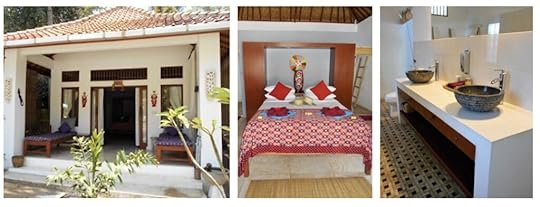 Our bungalow was luxurious and the resort’s swimming pool was fabulous
Our bungalow was luxurious and the resort’s swimming pool was fabulous Our bungalow on Gili Meno was luxurious and the resort’s swimming pool and sun lounging area was fabulous. Just a short walk away was the beach and on our first afternoon we took a leisurely walk around the whole island.
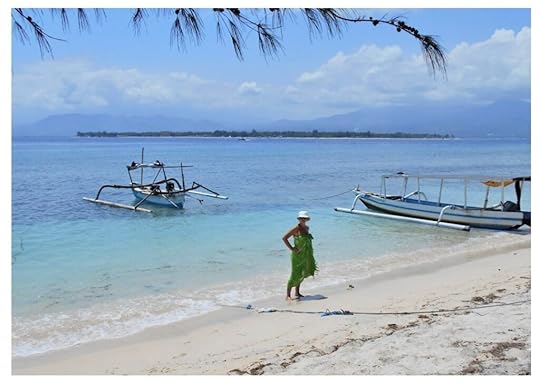 On Gili Meno with Gili Air in the background
On Gili Meno with Gili Air in the background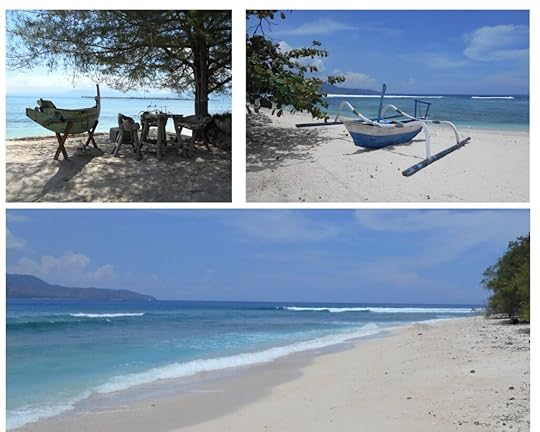 Gili Meno beaches and boats – all the blues
Gili Meno beaches and boats – all the blues A walk around the island…
A walk around the island… 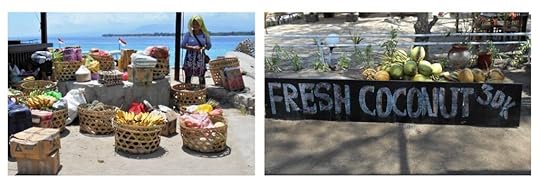 Fresh fruit and coconuts
Fresh fruit and coconuts Gili Meno… resting points on the beach
Gili Meno… resting points on the beachOur walk around the island only took only an hour and then we found ourselves right back where we started and at a fabulous beach restaurant for lunch. It was a spot that we soon we adopted as our favourite place to drink and eat and watch the sun going down on Gili Meno each evening during our stay.
I kept having to pinch myself because it was all so incredibly beautiful!
 Sunset dinner on Gili Meno
Sunset dinner on Gili MenoThe only downside to all this relaxation and indulgence was that on our last day on Gili Meno, I suffered a bout of sunstroke. I’d spend most of our days lounging around the pool in the hot sun when by our final evening I began to feel very ill. Unfortunately, we’d planned another lovely sunset dinner on the beach, which we then had to abandon.
Thankfully, I was more or less recovered by morning, as we had two boats and flight from Bali to Kuala Lumpur the following day. And, it has to be said that after ten days spent in paradise, we were really sad to leave.
We felt we could have stayed in this paradise forever.
Or at least carry on exploring the island chain along this stunningly beautiful archipelago beyond Bali.
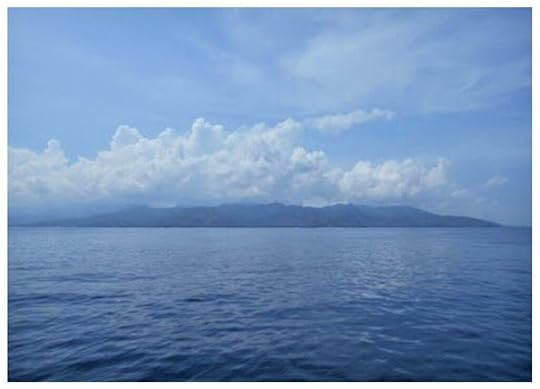 The larger Island of Lombok as seen from Gili Air
The larger Island of Lombok as seen from Gili AirIndeed, the island of Lombok looked appealing and the journey onward further to Flores and the islands of The Komodo National Park, and what an adventure that would be. But, alas, one for another time perhaps, as we did have a return flight booked to take us from Bali back to Kuala Lumpur.
And from Kuala Lumpur – our base and the gateway to Asia – we knew we could pretty much go anywhere!
Have you ever been to Bali?
If so, what were your impressions?
If not, is it on your travel wish list?
Have you travelled to The Gili Island?
If so, which island was your favourite?
Let me know! Get in touch!
Contact me through my contact page or via my social media.
I’d love to hear from you.
The post Island Hopping – Beyond Bali to The Gili Islands appeared first on The Backpacking Housewife.
December 14, 2021
Island Hopping – Philippines
How on earth do you plan to go island hopping in the Philippines when the island country comprises of over 7,000 individual and diverse islands? How do you narrow down your itinerary to suit your travel budget and timescale? These are the issues we faced while planning our first ever island-hopping trip to the Philippines. Join me and my backpacking husband on our fabulous adventure!
Further investigation, however, uncovered that the Philippines are divided into three main groups.
These main regional groups of islands are known as Luzon, the Visayas, and Mindanao.
But which to choose? I suppose, it all comes down to what you want to see and do in the Philippines.
The Backpacking Housewife Guide To Island Hopping In The PhilippinesIf you are looking for the excitement of city life then you might prefer to fly into the nation’s metropolitan capital and commercial centre, Manila, also the principal city. Or, for interesting history and culture, you might head for Iloilo City, known for historic landmarks and Spanish colonial churches.
 If you are looking for the excitement of city life then you might prefer to fly into Manila
If you are looking for the excitement of city life then you might prefer to fly into Manila Alternatively, Mindanao is the southernmost group of islands, and the main city is called Davao. Here you’ll find Mount Apo, Eden Mountain Resort, lakes, enchanted rivers, incredible waterfalls, and more durian fruit and coconuts than you could ever imagine!
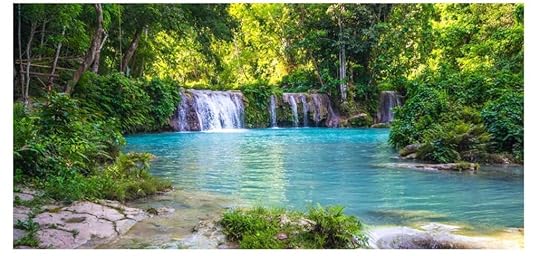 Mindanao is the southernmost group of islands and here you’ll find enchanted rivers, incredible waterfalls, and more
Mindanao is the southernmost group of islands and here you’ll find enchanted rivers, incredible waterfalls, and more We were looking for beautiful tropical white sand beaches, warm clear seas, and coral reefs!
 We were looking for beautiful white sand beaches, warm clear seas, and coral reefs
We were looking for beautiful white sand beaches, warm clear seas, and coral reefsThe backpacking husband is an adventurous (and highly qualified) scuba diver and high on his bucket list was to dive in the Philippines, where he hoped to encounter white tip and hammerhead sharks and in particular, the magnificent thresher sharks, and for this reason we decided to stay on islands offering the best diving and hotel resorts offering excellent scuba diving facilities.
We already knew that island of Malapascua’s Monad Shoal in the central Philippines archipelago of the Visayas, is one of the best shark diving locations in the Philippines and known as the only place in the world where Thresher Sharks can be closely observed on a regular basis.
I’m not a scuba diver myself but I do enjoy islands and beaches and boats!
For this reason, we chose to do our island hopping in the Visayas staying at dive resorts – not that you need to be a diver to appreciate this island hopping guide however – as I’m not a scuba diver myself but I do enjoy islands and beaches and boats!
 We chose to do our island hopping in the Visayas.Our Island Hopping Itinerary:
We chose to do our island hopping in the Visayas.Our Island Hopping Itinerary:Cebu Island
Malapascua Island
Bohol Island
Siquijor Island
Negros Island
Island Hopping Guide – The VisayasCEBUCebu is the main city of the Visayas, Philippines. We arrived on an Air Asia flight from Kuala Lumpur, the capital city of Malaysia, in the late afternoon and took a taxi from the airport into Cebu City. To my amazement, the traffic was crazy busy, and a journey that by my estimation should have only taken us around 30 minutes, took many hours.
Luckily, as we’d eventually arrived at dusk, we’d booked to stay overnight in a small hotel in Cebu.
In planning our island hopping trip in Philippines, I had booked ahead with all our chosen hotels and resorts along our island hopping route – staying exclusively with various scuba diving resorts on this trip – but I hadn’t yet organised our inner-island or inter-connecting travel.
I had thought travel throughout the islands of the Philippines would be well organised. I couldn’t have been more wrong!
The reason for this was that, having already travelled extensively throughout Thailand, including to many of the islands, where onward travel is easily arranged via large ferry boats, speedboats, or traditional longtail boats, I had thought travel throughout the islands of the Philippines would be similarly well organised. I couldn’t have been more wrong!
Planning our Island Hopping in The PhilippinesI soon found out that travelling from A to B on the islands might be simple enough, with scheduled buses and local Jeepney trucks and taxis readily available, but travel between one island and another was much harder to arrange and not always possible.
I had planned the first leg of our trip heading north to the island of Malapascua, where we planned to stay for a whole week, and from there to travel directly – by sea – to the island of Bohol for a few days, from where we would then continue south, once again by boat, to the island of Siquijor or ‘fire island’ as it is known because of the way it glows at night with fireflies. After which, we planned to travel back across the sea to Dauin to spend Christmas at El Dorado Resort on the island of Negros.
The backpacking husband was looking forward to all the scuba diving. I was looking forward to exploring the islands, the beaches, snorkelling on the reef and then working on my tan on a poolside lounger.
But, it was explained to us, that an onward journey by sea from Malapascua wasn’t actually possible due to sea conditions and the distance involved. We were told we’d have to retrace our steps instead, returning along the coastal road to Cebu in order to travel from the main port by boat over to the island of Bohol and then return to Cebu once again to travel by boat to Siquijor island.
I then realised that I’d made a rookie travel mistake. I’d anticipated our travel plan through assumption rather than fact finding and so the distances we actually needed to travel to complete our island hopping itinerary in the Visayas would be at least double what I’d first estimated.
And double the distance also meant double the cost and so our budget was completely blown!
A valuable lesson had been learned. Never again will I simply ‘imagine’ the direction of the trip and how we might get to where we planned to go just by looking at a Google map and seeing how a crow might fly or a boat might sail!
We consulted with the manager/owner of our hotel in Cebu with regard to taking a local bus north to the Port of Maya in the morning when it was possible to take a boat over to Malapascua island.
He told us the local bus would take 4-5 hours depending on stops. Another option would be to take a jeepney truck, but he warned us it would only actually leave Cebu when it was full of passengers.
Or, we could arrange private taxi with a non-stop journey time of around 3 hours to take us to the port. With his helpful assistance, a private taxi and a driver was quickly negotiated over and arranged and the next morning, in great excitement and anticipation for the day ahead, we met with our friendly driver and we headed out into the crazy and chaotic Cebu traffic.
 We headed out into the crazy and chaotic Cebu traffic
We headed out into the crazy and chaotic Cebu trafficWhere we sat for an hour while inching our way along one steamy street, laced with thousands of low swinging and treacherous looking overhanging power cables, packed with cars and trucks lined bumper to bumper, many belching out black fumes that seeped into our car through holes in the floor and rattling air vents.
The only vehicles moving through the line were the continuously beeping scooters that seated whole families, that bravely weaved in and out of the crazy but colourful Cebu City congestion. Eventually, our driver saw an opportunistic gap in the traffic jam when a truck on the next lane had an engine stall.
With a tyre screech and an engine roar, we swerving into a side road, breaking free from the seemingly endless traffic jam and finally headed out onto the (perilously) winding coastal road instead.
 Our journey plan from Cebu to Malapascua Island
Our journey plan from Cebu to Malapascua IslandThroughout the journey, I gazed out of the window at a cloudless blue sky and a sparkling blue sea, and I anticipated our long awaited and dreamed of arrival at Kokay’s Maldito Dive Resort on the tiny island of Malapascua.
After travelling along the coast road for another three hours, we arrived at the end of the road, literally, and there waiting for us was a traditional outrigger or ‘pump boat’ to take us over to Malapascua Island.
We spilled out of our taxi, grateful for the fresh sea air and to stretch our legs, and the crew were immediately helpful. They enthusiastically wrestled with the backpacking husband’s bulky dive gear and my own backpack, carrying them balanced across their shoulders and onto the boat.
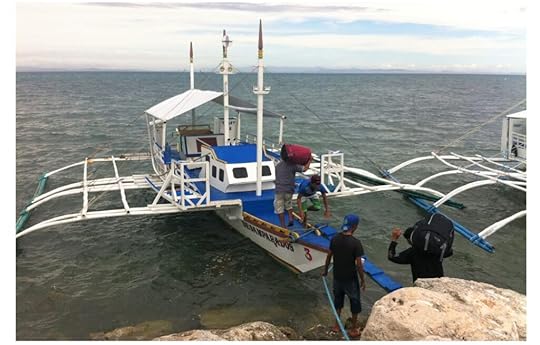 Our backpacks being carried onto the boat over to Malapascua Island
Our backpacks being carried onto the boat over to Malapascua IslandThe wind had whipped up here at the Port of Maya, which wasn’t actually a port as you might expect. There wasn’t a pier or any docking places – only large slippery looking rocks and a rolling tide beneath a precariously balanced gangplank leading to the undulating boat. The journey to Malapascua, over a rough sea, took about 40 minutes.
Our Lost Phone Story!It was during this journey, and as the island and the resort came into view over the swell of the waves, that the backpacking husband suddenly realised that he’d left his phone on the back sea of our taxi that was now heading back to Cebu.
Panic set in. What would we do now? How would we manage?
This phone was to have been our technical lifeline while travelling because it had the local SIM in it that we’d bought at the airport, to provide internet access to our itinerary and bookings and the data and communication we needed for our banking and airline boarding passes.
My own phone was useless because it didn’t have a SIM in it at all as I’d taken it out so that I didn’t get stung with any huge international roaming fees. So, it was basically just a camera.
We both realised that realistically we were never likely to see that phone again.
After all, it might have slipped behind the seat and so disappeared forever.
Or it might be found by the next passenger who might claim it for themselves – and who could really blame them when returning it to us was likely impossible. The sinking feeling of disconnection we were suffering in that moment was however temporarily relieved by our new appreciation of the beautiful scene that awaited us on the beach.
The hotel staff in their colourful uniforms had assembled to greet us with a cold towel, beaded necklaces, and a welcome cocktail.
We might not have a phone but we had finally arrived in paradise!
And, as it turned out, we needn’t have worried or despaired because our trusty taxi driver had found the phone on his back seat, and he’d already sent a message to our hotel to say that he’d handed it to the boat crew, who were bringing it across to us on the next boat.
A little story about losing a phone but one that perhaps reminds us to always find faith in people.
MALAPASCUAMalapascua is a small island by any standards. Its length is 2.5 kilometres and it is only 1 kilometre wide. However, there are plenty of options for accommodation on the island and that includes budget, mid-range, and high-end hotel properties and resorts.
The island is famous with the scuba diving community as the only place in the world where you are guaranteed to see Thresher Sharks every morning. This is because the reef here is a cleaning station for the sharks and they come because it’s where the wrasse, a type of cleaner fish, congregate.
 Malapascua is the only place in the world where you are guaranteed to see Thresher Sharks every day!
Malapascua is the only place in the world where you are guaranteed to see Thresher Sharks every day!Malapascua diving is 100% eco-friendly and sustainable and diving rules are strictly enforced here to make sure it’s safe for everyone, including the sharks. Take note that diving to see the Thresher Sharks is open only to divers with at least an Advanced Open Water Diver certification.
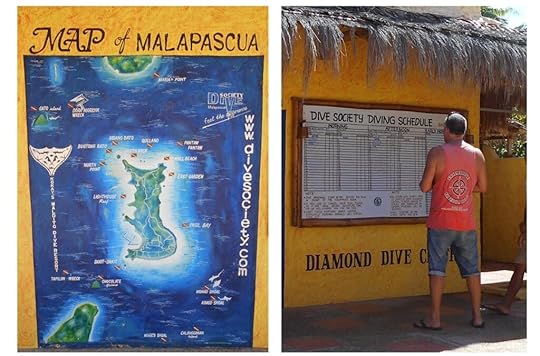 The backpacking husband checks out the dive schedule
The backpacking husband checks out the dive scheduleAnother notable diving spot from Malapascua is off Gato Island.
Gato Island is known as an underwater wonderland featuring coral and rock formations and underwater tunnels. My backpacking husband was planning to dive there too. I was keen to join him on the boat so I could enjoy snorkelling there.
On the boat, I kept well out of the way while all the divers and their dive buddies prepared the gear for their dive and while they entered the water. Then I put on my own fins and my full-face snorkel mask and jumped in too.
 Another notable diving spot from Malapascua is off Gato Island.
Another notable diving spot from Malapascua is off Gato Island.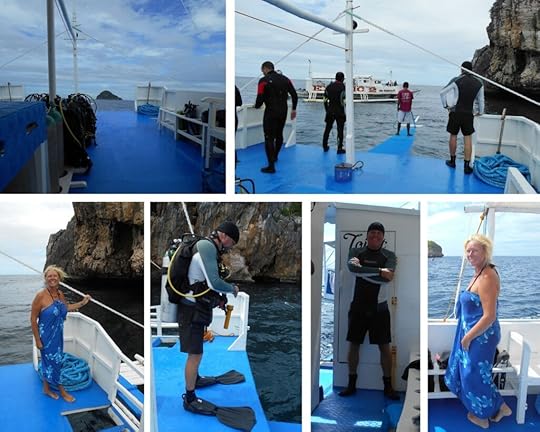 Getting ready to dive at Gato Island!My Scary Sea Snake Story!
Getting ready to dive at Gato Island!My Scary Sea Snake Story!I swam over to the small island and spent some time floating around on the surface of the warm clear water looking down at the rocks on the sandy bottom and at all the snakes I saw there. The snakes were large and striped and I guessed, as we were in the Philippines, they were highly venomous. I was also very glad that those snakes were many meters below me on the bottom of the sea and not anywhere near me, as then I’d certainly not have been so fascinated or so curious about them.
I thought I heard someone shouting from the boat and so I lifted my head to see and indeed, one of the crew was waving his arms in my direction and shouting something. I took off my full-face snorkel mask and listened to him shouting ‘lady, lady, snake… snake!’
And then I realised I was closely surrounded by snakes on the surface of the water all around me.
I probably don’t need to tell you that I swam back to the boat and left the water in double-quick time. The crew, who had obviously been concerned when they warned me of the danger that I was in, were now laughing and joking at my expense and delighted in telling me that the Black Banded Sea Krait – which were the snakes in question – where the most venomous snakes in the whole world.
My backpacking scuba diving husband however assured me that they are incredibly docile creatures who need to come up to the surface for air and that they would only attack if they’d felt threatened.
I wondered if me thrashing about in the water, while attempting to swim as fast as a speed boat right through the lot of them, might have felt threatening to them?
I stayed on the boat after that and left exploring the marine sanctuary to the professionals.
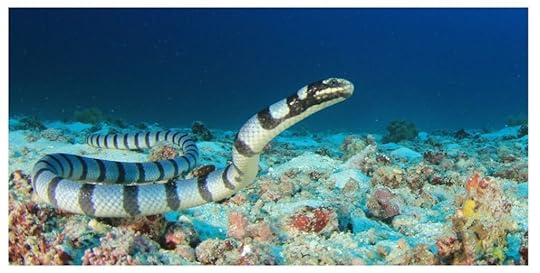 Who knew sea snakes had to come up for air?
Who knew sea snakes had to come up for air?Our stay on Malapascua island was all and more than we ever thought possible.
Our hotel – we had booked a premium room – was gorgeous. The view of the beach and the sunset from our balcony was fabulous. The weather was amazing at around 39 deg C. The food in the resort restaurant was wonderful and, as Christmas was just over a week away, the atmosphere was festive (in such a tropical place!) with a sparkling Christmas tree set up in the bar.
 Our accommodation was gorgeous with a sparkling Christmas tree set up in the bar.
Our accommodation was gorgeous with a sparkling Christmas tree set up in the bar.The dive centre and staff at Dive Society at Kokay’s Maldito Dive Resort were super friendly and wonderfully professional. Within days of our arrival on the island they became great friends. To this day, we have such fond memories of the special people we met on Malapascua island, and I’m happy that we all stay regularly in touch and keep up with each other’s lives from afar.
On our last night on Malapascua, our new friends surprised us with a farewell party.
 Last night sunset: photo taken from our room on Malapascua Island
Last night sunset: photo taken from our room on Malapascua IslandOn our last night on Malapascua, we decided to buy a bottle of rum in the local shop to take along to share at our farewell party and we headed over to the dive centre at the time we’d been asked to arrive – to find that our friends had strung up lights around the tikibar, that there was lively music blasting out from the outdoor speakers – and there was lots of chicken cooking on the barbeque.
Lots of drinking and dancing and eating and laughing took place that night. It was fabulous!
 My Facebook Post the next day following our leaving party!
My Facebook Post the next day following our leaving party!We didn’t feel quite so lively or fabulous the next day, however, when with horrible hangovers we had to get back on the outrigger to sail across the rolling sea and embark on a ten-hour onward journey over to the island of Bohol and Blue Star Dive Resort.
BOHOLWe planned to stay four nights on Bohol. We took a car across the island to our accommodation at Blue Star Dive Resort and really enjoyed our impromptu tour of the island along the coastal road to the village of Anda.
We passed local people busy shopping and chatting. School children walking or cycling to school in their smart uniforms. And, as we trundled slowly through their village, we had a privileged glimpse of their everyday routines – drying coconut and rice on sheets at the side of the road – living their everyday lives. Lives that from an outsider’s point of view seemed richly fascinatingly.
 Our journey plan from Malapascua Island via Cebu Island to Bohol Island
Our journey plan from Malapascua Island via Cebu Island to Bohol IslandBohol is a large island and it is famous not only for its 261 kilometres of coastline and beaches but for its ‘chocolate hills’ in the interior that are mounds that turn chocolate brown in the dry season. (November – May). Bohol is also famed for its indigenous and cute primate – one of the world’s smallest primates – the tarsiers.
 There are lots of epic things to do and see on Bohol
There are lots of epic things to do and see on Bohol I’m sure there are lots of epic things to do and see on Bohol – and there’s lots of information already out there on the internet on where to go and how to see it – but we were focussed primary on the diving (the backpacking husband) and relaxing and reading (me) while experiencing these beautiful islands in the region of the Visayas.
I didn’t plan on venturing out on the dive boat much myself here because most of the diving off Bohol is for experienced divers only rather than snorkelers. The fast currents of the Sulu Sea provide thrilling drift dives and the steep coral walls offer advanced divers interesting deep dives.
I have to say that I was seriously impressed with our amazing accommodation and with Blue Star Dive Resort.
 I was seriously impressed with our amazing accommodation at Blue Star Dive Resort
I was seriously impressed with our amazing accommodation at Blue Star Dive ResortThere are only 10 rooms at the resort. Our Ocean View Deluxe room for the four nights here was a gorgeous palm thatched bungalow with a balcony that overhung the edge of the cliff and offered stunning views over Guindulman Bay.
The dive centre at Blue Star on Bohol is a 5 Star PADI Resort.
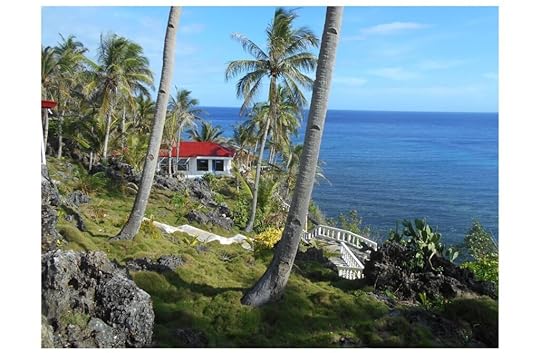 The dive centre at Blue Star on Bohol is a 5 Star PADI Resort
The dive centre at Blue Star on Bohol is a 5 Star PADI ResortThere is also a sun terrace with comfortable loungers and a swimming pool and a jacuzzi. The resort itself is perched on the edge of a cliff with fabulous views over the sea. We had arrived at night and the view offered to us from our room at daybreak when I opened our curtains the following morning was simply breath-taking.
 When I opened our curtains the following morning the view was simply breath-taking.
When I opened our curtains the following morning the view was simply breath-taking.So, from our private balcony each morning, I could have my coffee and wave off the backpacking husband as he left on the outrigger to go diving. In the daytime, I could relax and read and swim in the beautiful pool. And, in the evening, we could dine on the terrace together in the open-air restaurant and watch the sun going down on the sea. Absolute paradise!
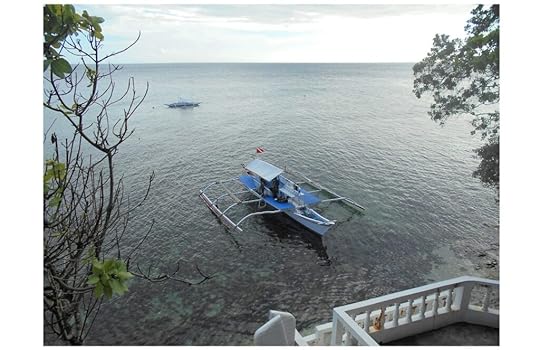 Early morning dive boat
Early morning dive boat In the evening: dining on the terraceSIQUIJOR
In the evening: dining on the terraceSIQUIJORAfter our adventurous (him) and totally relaxing (me) and laid-back time on the island of Bohol, it was time for us to leave and retrace our journey once again back to Cebu so that we could travel over to the island of Siquijor.
I was so excited to experience Siquijor… as it has a reputation for being ‘other worldly’.
The island is also known by Filipinos as ‘the fire island’ because it is famous lit at night by the glow of millions of fireflies.
The locals also talk of witchcraft being practiced on the island by its natural healers and spiritual shaman and so the island has both a magical and a bewitching appeal.
Again, we were there for the beautiful beaches and clear warm coral seas and the famous sunsets, and we were staying at Coco Grove Beach Resort for which I was in great anticipation. According to the website – and you must take a look – it offers the guest a long stretch of white beach surrounded by crystal blue sea with spectacular marine life, complete relaxation by the three swimming pools and rejuvenation in the tropical gardens, and unbelievably beautiful sunsets.
And, of course, for the backpacking house husband there is a scuba diving centre and the Tubod Marine Sanctuary directly in front of the resort that encompasses a vibrant coral reef with intermittent sandy areas and seagrass beds that are festooned with tropical fishes, octopus, and turtles.

Our stay on Siquijor island and at Coco Grove Beach resort was perfect and idyllic. I have the fondest forever memories of beautiful and delicious breakfasts served to us by the pool. Of relaxing and reading in a hammock between the palm trees on that amazing white sand beach. Of feeling the hot tropical sun on my skin as I sat at the swim up bar having an afternoon cocktail. Of watching the spectacular sunsets from our loungers by the pool while sipping sundowners. And enjoying romantic and fabulous seafood meals cooked simultaneously tableside and seaside by the resort’s expert chefs. It was all so incredible!
 A perfect start to a day in paradise: breakfast by the pool
A perfect start to a day in paradise: breakfast by the pool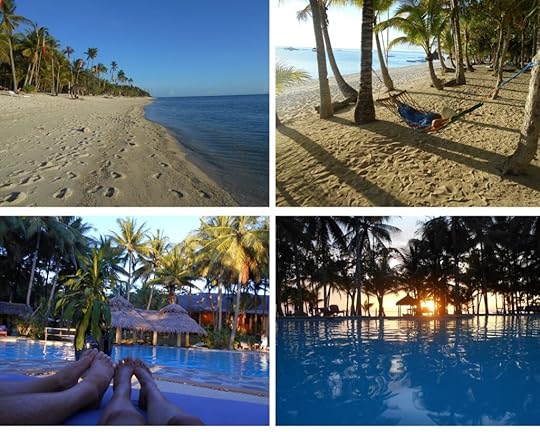 Relaxing in a hammock between the palm trees or watching a sunset from our loungers by the pool
Relaxing in a hammock between the palm trees or watching a sunset from our loungers by the pool Our stay on Siquijor island and at Coco Grove Beach resort was perfectNEGROS ISLAND
Our stay on Siquijor island and at Coco Grove Beach resort was perfectNEGROS ISLANDAfter our wonderful time on Siquijor came to an end, we were in anticipation of our final island hopping adventure in the Philippines and the Visayas. We were heading next to Dumaguete and Dauin on Negros Oriental Island, in the southern Philippines, where we planned to stay over Christmas.
We were staying at El Dorado Beach Resort – which like the dive centre we’d loved so much on Malapascua island – was owned by The Dive Society in the Philippines. The backpacking husband was particularly looking forward to lots of diving here where there are so many fabulous dive sites and particularly diving off Apo Island – a small volcanic island which is a protected marine sanctuary – and listed as one of the top ten dive sites in the world.
 The backpacking husband was particularly looking forward to lots of diving from Dauin at Negros
The backpacking husband was particularly looking forward to lots of diving from Dauin at NegrosWe had a wonderful few days at El Dorado Resort and a fabulous never-to-be-forgotten day out on the dive boat when I too once again braved the tropical waters for an amazing snorkelling experience amongst colourful corals and fabulous marine life.
 We had a wonderful few days at El Dorado Resort
We had a wonderful few days at El Dorado ResortUnfortunately, our plans for Christmas and for diving with Dive Society in the Philippines was abruptly cut short when the weather suddenly changed and all boats were tied up and the diving cancelled. A weather warning was issued and then soon heightened to a typhoon warning. Everyone at the resort began to prepare for the incoming storm by further securing the boats and battening down the hatches. It seemed that all diving would be cancelled.
 The weather warning was then heightened to a typhoon warning!
The weather warning was then heightened to a typhoon warning!We decided that as there was no more island hopping or scuba diving in our immediate future and that Christmas was likely to be a scaled down considerably in the Philippines – that we would take advantage of the last scheduled flight from Dumaguete back to Kuala Lumpur – and that we’d have our Christmas in Malaysia instead!
End Note: A while after our stay at El Dorado, we heard from our friends that sadly, the Dive Resort at Dauin on Negros Island had suffered a terrible fire and burned to the ground. Thankfully no one was hurt but the resort suffered a lot of damage. For this reason, I’ve not included a website reference to our stay here.
Christmas spent abroad and particularly Christmas in the tropics is pretty amazing, and having spent many previous winters and Christmases in Scotland, for us it’s also a bit of a novelty to spend Christmas in beach clothes and flipflops!
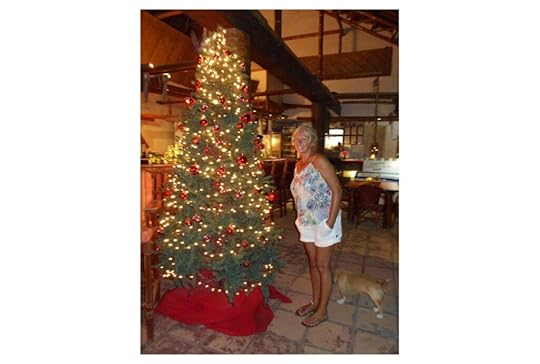
Have you ever island hopped the Philippines?
Is island hopping in the Philippines on your travel wish list?
Have you ever been scuba diving in the Philippines?
Have you ever spent Christmas in the tropics?
The post Island Hopping – Philippines appeared first on The Backpacking Housewife.
December 7, 2021
Island Hopping – Andaman Sea Thailand
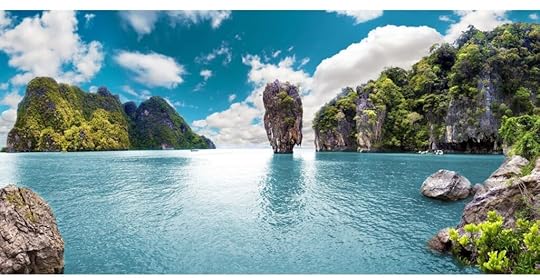
Did you know there are well over a thousand tropical islands scattered like verdant jewels along Thailand’s coastlines both on the Andaman Sea and in the Gulf of Thailand?
This makes Thailand a world-class tropical island-hopping paradise!
Some of these islands are on a popular tourist trail and others are a little off the beaten path.
And, with transport along the coast so easily arranged via local and traditional longtail boats or private speedboats boats and scheduled ferries, there are many ways to island hop and many different routes to choose simply because there are so many stunningly beautiful islands to explore.
I have been lucky enough – and sometimes adventurous enough – to visit and explore many of these islands off the duel coastlines of Thailand: The Gulf of Thailand and The Andaman Sea.
THE GULF OF THAILANDI’ve travelled from Chang Mai in the north of Thailand on busses and trains to get to Bangkok in the south and then I’ve travelled to the Gulf of Thailand, down through Pattaya on the eastern coast (the side bordering Cambodia) by various means including busses, cars, and tuk-tuks, and then by ferry boat over to Koh Chang (Elephant Island) and to Koh Mak and Koh Kood. Travel is always an adventure and you certainly meet the most interesting people on buses and boats and trains!
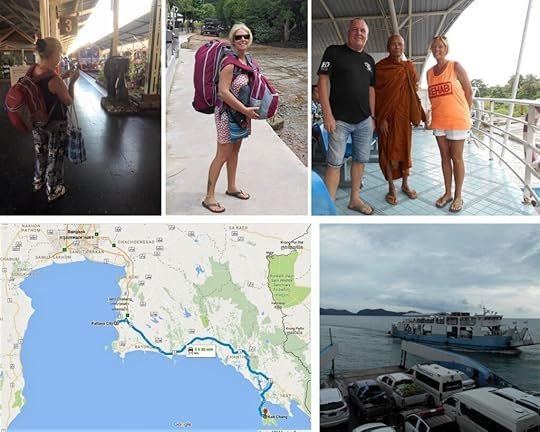 I’ve travelled to the Gulf of Thailand, down through Pattaya on the eastern coast (the side bordering Cambodia) by various means including busses, cars, and tuk-tuks, and then by ferry boat over to Koh Chang (Elephant Island)
I’ve travelled to the Gulf of Thailand, down through Pattaya on the eastern coast (the side bordering Cambodia) by various means including busses, cars, and tuk-tuks, and then by ferry boat over to Koh Chang (Elephant Island)I’ve also flown into Surat Thani airport on the western shore of the Gulf of Thailand and then taken a bus up the coast to Hua Hin. On another occasion, I’ve also taken a bus from the airport to the port at Chumphun and then a ferry boat over to the Gulf Coast islands of Koh Samui, Koh Phangan, and Koh Tao.
There are three ferry companies to choose from on Thailand’s Gulf Coast: Lomprayah, Seatran and Songserm.
The Lomprayah Service is the fastest direct service in the Gulf of Thailand from Surat Thani Airport.
I prefer to use and would recommend to you the The Lomprayah service as it uses luxury buses and high-speed catamaran ferries and you can conveniently buy tickets on arrival at the airport for a complete airport to island service.
THE ANDAMAN SEAIsland Hopping – The Andaman Sea – One of My Greatest Travel Experiences!One of my greatest ever travel experiences – and the subject of this post – is island hopping on Thailand’s Andaman Sea. The backpacking husband and I spent a month backpacking all along the Andaman Sea, on the southwest side of Thailand, using ferries and speedboats and traditional longtail boats all the way from Krabi Thailand down to Langkawi in Malaysia.
From Krabi to Railay and from Koh Lanta to Koh Kradan and to Koh Ngai we took a local longtail boat.
 The Backpacking Housewife travelling by longtail boat
The Backpacking Housewife travelling by longtail boatFrom Railay to Koh Lanta we used a local ferry and then a minibus (the out of season route) to take us a little further down the coast and then we took a ferry across to Koh Lanta as it was early season and just before the main ferry and boat services along the Andaman Sea had started up.
Otherwise we used The Bundhaya Speed Boat service to access all the islands on the Andaman Sea.
On the Andaman Sea, you’ll find so many tropical islands that are so visually stunning that you’ll hardly believe they are real.
Many have verdant jungle interiors and are fringed by some of the most beautiful – and most photographed – beaches in the whole world. You will find popular islands like Koh Phi Phi Ley (of The Beach fame) and other ‘tourist magnets’.
But you’ll also discover many other islands dotted along this coastline that are so small that they often get bypassed by the island-hopping crowds looking for beach parties and so choosing to stop off on one of these can almost make you feel like you’ve been castaway on a desert island.
These smaller paradise islands are the ones we chose to stop at on route, to stay for a few lazy days and nights in palm thatched huts and resting in a hammock under swaying palm trees on stunning white sand beaches, or exploring limestone caves, snorkelling, or scuba diving on a coral reef.
While travelling along the Andaman Sea, we saw lots of uninhabited and impressive limestone monuments and tall rock stacks jutting out of the water. Hewn by the waves, some are strange shapes and resemble animals or birds and are named as such: there’s Koh Kai or ‘chicken island’.
Some of these hewn limestone rocks and islets on the Andaman Sea are famous as landmarks, like Koh Ta Pu, otherwise known as ‘James Bond Island’ because it appeared in the 1974 James Bond movie ‘Man With The Golden Gun’.
You’ll realise now that the word for island in Thai is ‘koh’.
And I want to share with you our fabulous island-hopping adventure on the Andaman Sea Thailand so that you’ll know how to do it too!
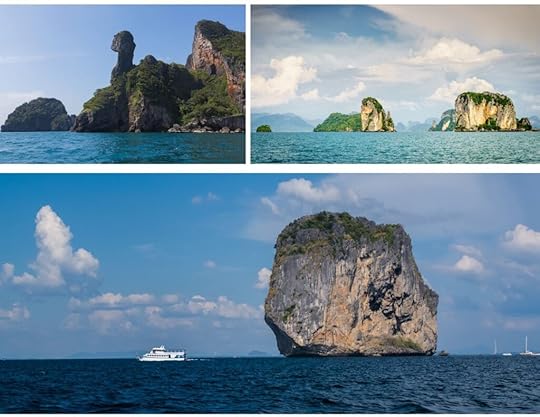 Hewn by the waves, some islands are strange shapes and resemble animals or birdsOUR ISLAND HOPPING ROUTE ON THE ANDAMAN SEA THAILAND
Hewn by the waves, some islands are strange shapes and resemble animals or birdsOUR ISLAND HOPPING ROUTE ON THE ANDAMAN SEA THAILANDKrabi. Railay. Koh Lanta. Koh Phi Phi Ley. Koh Ngai.
Koh Kradan. Koh Mook. Koh Bulon. Koh Lipe
Langkawi (Malaysia)
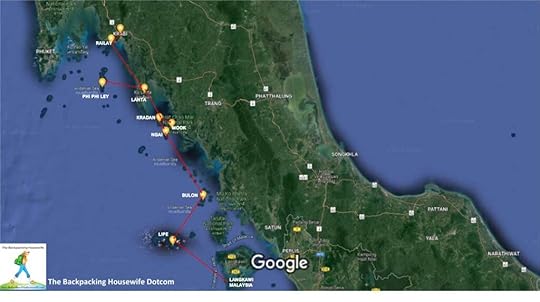 Our Island Hopping route from Krabi Thailand down to Langkawi MalaysiaTHE BEST TIME TO GO ISLAND HOPPING ON THE ANDAMAN SEA THAILAND
Our Island Hopping route from Krabi Thailand down to Langkawi MalaysiaTHE BEST TIME TO GO ISLAND HOPPING ON THE ANDAMAN SEA THAILANDKnowing the best time to island hop in Thailand visit is very important because the two sides that I’ve mentioned – The Andaman side and The Gulf side – have totally different and opposite monsoon seasons.
On the Gulf of Thailand – the high ‘dry’ season is from February to September and the rainy season is from October to January.
On the Andaman Sea – the high and ‘dry’ season is December to April and the rainy season is May to November. Be warned that in rainy season – when the sea swell is high – boats and ferries will not be in service and many hotels, resorts, and restaurants, will be closed for the rainy season.
We began our Andaman island-hopping trip in mid-November just as the season was getting started.
We flew from the UK to Bangkok and then took a domestic flight over to Krabi.
From Krabi, we were able to take a longtail boat around the headland to Railay Beach.
 Waiting for a longtail boat – Krabi to Railay BeachKRABI AND RAILAY
Waiting for a longtail boat – Krabi to Railay BeachKRABI AND RAILAYGoing to Railay Beach was actually a bit of a diversion from our island-hopping route, because it’s not an island, but an area of peninsular that’s cut off from the mainland. It’s protected by mangroves and jungle and magnificent limestone cliffs and so it’s only accessible by boat.
Railay has a reputation as one of Thailand’s most stunning scenic places.
It’s a place I longed to see with my own eyes, having only ever seen amazing photographs of Railay’s sheer limestone cliffs, incredible white sand curved beaches, and crystal-clear waters.
Readers of my Backpacking Housewife books will know that in Book One, my heroine of the story, Lori, also travels from Bangkok and to Krabi and then my traditional longtail boat to Railay Beach!
 My Backpacking Housewife series of books published by HarperCollins
My Backpacking Housewife series of books published by HarperCollinsMy heroine, Lori, also travels to all the other islands that I travel to as part of this fabulous island-hopping trip. I’ve used my very own experiences of travelling along the Andaman Sea to meld with Lori’s (fictional) story and readers of my Backpacking Housewife books have contacted me to say that they too have since travelled this route – or plan to do so – after reading the book and being inspired by my travels. I think that is truly wonderful!
We arrived at Railay on 31st October – Halloween – and just in time to attend a Halloween beach party! We bought our tickets and attended that night for a fabulous Halloween themed spooky food buffet and to dance to live music on watch fire dancers perform on the beach. It was wonderful!
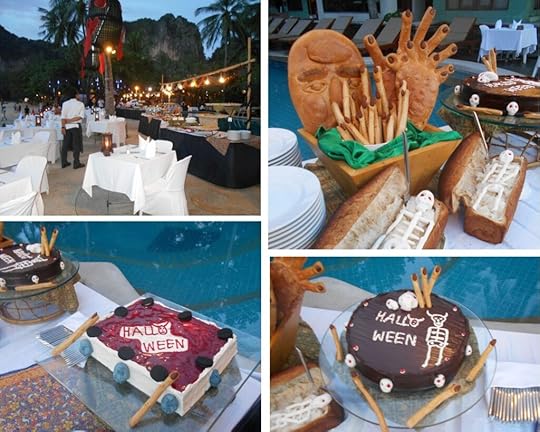 We arrived at Railay on 31st October – Halloween – and just in time to attend a Halloween beach party!
We arrived at Railay on 31st October – Halloween – and just in time to attend a Halloween beach party!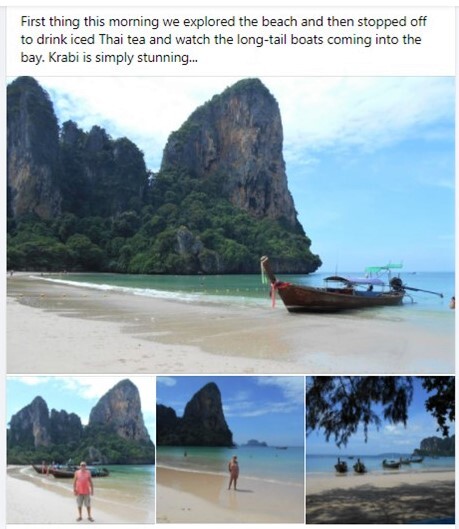 My Facebook Update from RailayKOH LANTA
My Facebook Update from RailayKOH LANTAOur real starting point on our three-week island-hopping adventure is on Koh Lanta, the largest island in this chain along the Andaman Sea. Koh Lanta’s reputation as a relaxing laid-back paradise more than appealed to me.
So, to take things slowly and truly soak in the relaxing tropical island vibes of the gorgeous uncrowded white sand beaches, unpretentious beach bars, incredible sunsets, and the hedonistic atmosphere promised to us by this island, we decided to spend two weeks here.
Another reason to stay here longer was the time of year. We arrived on Koh Lanta in early November at the very beginning of the season and we had to wait for The Bundhaya Speed Boat service to start up to facilitate our island hopping further down the Andaman Sea.
We stayed at Mook Lanta Eco Resort in a gorgeous wood bungalow on stilts and it was wonderful.
The backpacking husband also wanted to go scuba diving from Koh Lanta and he dived with the wonderful Andaman Dive Adventures – a 5-star PADI dive centre.
 Andaman Dive Adventures Koh Lanta
Andaman Dive Adventures Koh LantaThere are spectacular coral reef dive sites nearby – all considered to be the best diving in Thailand.
Hin Daeng (red rock) and Hin Muang (purple rock), Koh Bida Nok and Koh Bida Nai, and of course the famous Koh Phi Phi (The Beach) and the further away dive sites of Shark Point and Anemone Reef
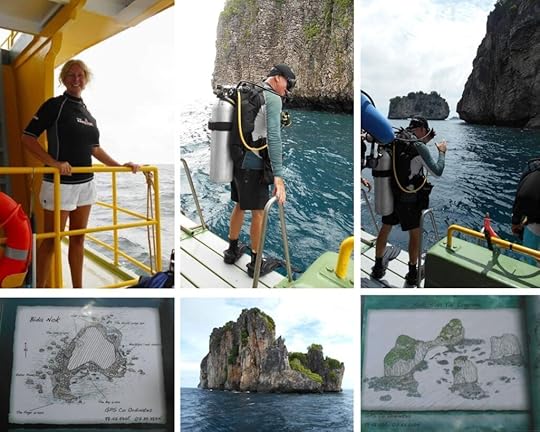
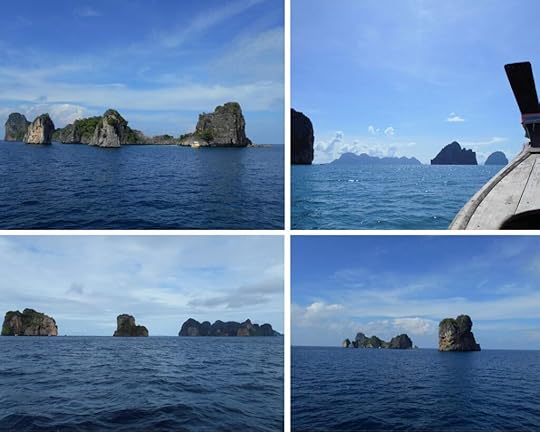
Some days I joined him out on the dive boat and, as I don’t dive, I enjoyed the views from the boat and I went snorkelling instead. I’ve never seen so many tropical fish. Even from the surface I could look down and see sea snakes, barracuda, cuttle fish, cat fish, and moray eels, box and trumpet and crocodile fish. It was incredible!
 My Facebook update from Koh Lanta
My Facebook update from Koh LantaOther days, I read in a hammock or sunbathed on the beach or went for a Thai massage.
I also attended a shala to practice my yoga. There are lots of yoga retreats on Koh Lanta.
The backpacking husband and I took romantic strolls on Long Beach and as it was so early in the season it was often deserted. We stopped off for ‘Leo’ or a ‘Chang’ beer and a bite of lunch at our favourite Moonwalk Beach Bar where we could relax on bean bag cushions at low tables made of driftwood and watch the sun go down while making memories that we know will last us a lifetime.
Koh Lanta is a truly fabulous laid back and relaxing tropical island destination!
 Long Beach Koh Lanta
Long Beach Koh LantaInterestingly, in my pre-departure planning and research, I’d also discovered Koh Lanta is home to the Chao Ley – ‘sea gypsies’ – who are thought to be the indigenous people of these islands. Ban Sangka-Ou, a fishing village in the southeast of Lanta Yai, is home to around 400 Chao Ley people. But you should know that the village, although not out of bounds, is not a tourist attraction.
After a fabulous two weeks on Koh Lanta we were relaxed and excited to be moving on to our next island of Koh Ngai. You can easily check the timetable for transport from Koh Lanta to Koh Ngai on the Amazing Lanta website.
KOH NGAI Koh Ngai by The Backpacking Housewife
Koh Ngai by The Backpacking HousewifeOn a calm sea and under a clear blue sky, the journey by longtail boat to Koh Ngai took a little under an hour.
Once at sea and during our voyage, I was mesmerised by so many ‘pinch me’ moments.
Meanwhile, our slight, weather-beaten, and happily smiling boat captain, who was both barefoot and bare-chested, smoked a cigarette and stood proudly at the back of his boat operating the ‘longtail’ – with its ancient and noisy diesel engine attached and also belting out smoke – with his foot.
I was enthralled by views of the coastline on one side of us and all the enormous rocks and towering limestone karsts in the sea all around us and on the horizon. On sailing past one of these limestone ‘islands’ we saw what looked like a long-abandoned bamboo hut with the wind torn remains of a palm-thatched roof. Our captain pointed to it and laughed.
‘Look!’ he delighted in telling us. ‘It’s your hotel!’
 “Look! It’s your hotel!’
“Look! It’s your hotel!’Our hotel on Koh Ngai was in fact far more luxurious and I was in great anticipation of our arrival.
We’d booked to stay for two nights at the fabulous Thanya Beach Resort.
According to my research for our trip, Koh Ngai is a tiny island that is part of the Koh Lanta National Park, and it promises us warm turquoise waters, a white sand beach, and a jungle clad hilly interior.
Unlike the much larger island of Koh Lanta, there are no cars or motorised vehicles on Koh Ngai or indeed any of the small islands on this route. Electrical power on the island is provided by generators.
There are no ATM machines and so its best to find out in advance if your hotel will take card payments.
There are also no TV’s but there is Wifi. To me, it sounded like a paradise.
As Koh Ngai came into view, it literally took my breath away. It looked so beautiful, so verdant, and so very inviting, like a tropical oasis shimmering on the blue green sea. Our accommodation at Thanya Resort on Koh Ngai was stunning too and typically Thai in that it offers small, clean, and well-furnished ‘deluxe’ bungalows set back from the white sand beach and in a garden of tropical flowers.
 Thanya Beach Resort Koh Ngai
Thanya Beach Resort Koh NgaiThere is also a small swimming pool and a poolside bar just back from the beach.
Koh Ngai is incredibly beautiful. It’s idyllic. It’s bliss. It’s the stuff of dreams!
Activities on offer, other that reading in a hammock and sipping cocktails on a lounger by the pool, are swimming, snorkelling, kayaking, scuba diving on the reef, beach wandering, and hiking through the jungle interior and over the hilltop to Ao Kuan Tong Beach. The official ‘Paradise’ trail is located behind reception at Thanya Resort.
The hike to Ao Kuan Tong Beach only takes around 20 minutes and is well worth the effort.
And, other that the above things to do, there is nothing to do so the island is low key and laid back.
 The Backpacking Housewife: Koh Ngai
The Backpacking Housewife: Koh NgaiAfter two amazing days and nights on Koh Ngai, relaxing and sunbathing and swimming and eating wonderful local food, we travelled a short distance by speedboat to the even smaller ‘slip of an island’ in this chain called Koh Kradan. The island is part of Had Chao Mai National Park.
Koh Kradan Koh Kradan: The Backpacking Housewife
Koh Kradan: The Backpacking HousewifeWhen you look up Koh Kradan – as you must – you will see that every reference to this long and narrow tropical island claims it as ‘the most beautiful island’ in the Trang Province.
Kradan has, in fact, often been voted as also having the world’s most beautiful beaches.
Again, it’s an absolute paradise, and again there are no cars, no roads, no stores, no ATMs.
The waters off the beaches are crystal clear, shallow, warm, and teeming with colourful fishes.
I was especially excited to read during my trip research about Koh Kradan’s famous sandbars – not the ones selling cocktails – but the white sand powder soft ones that are exposed when the tide goes out.
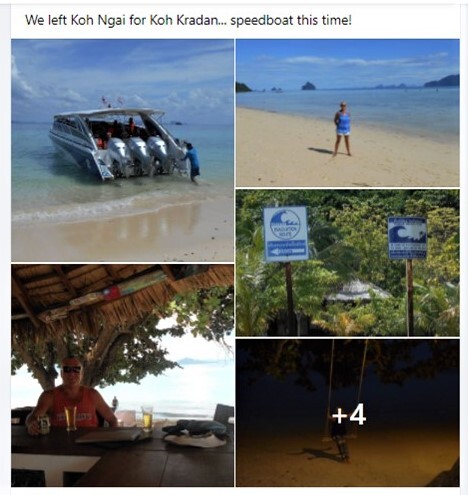 My Facebook update on Koh Kradan
My Facebook update on Koh KradanThese sandbars are just off the beach, accessed at low tide, through knee high clear and bath-water-warm aquamarine sea. I anticipated that walking on them would be like spending time on your own private island and that watching the sunset from that perspective would be absolutely magical.
Koh Kradan is an island with an interior of rolling hills and a pristine jungle as backdrop to the narrow palm fringed white sand beach off a submerged coral reef. On arrival, our boat dropped us off just out from the beach which meant us climbing out of the boat and wading ashore with our luggage – another reason to favour a backpack over a suitcase!
We stayed three nights on Koh Kradan in a bungalow in a row of sea view rooms at The Reef Resort.
We enjoyed cocktails at the onsite Polynesian style tiki-bar and we ate dinner in the hotel restaurant.
The Reef Resort is a gem and it’s the only hotel on Koh Kradan with a swimming pool. It was wonderful.
KOH MOOKJust opposite Koh Kradan is the picturesque Koh Mook (also known as Koh Muk – and muk means pearl in Thai – so it’s also called Pearl Island). The island is especially famous – and incredibly popular with tourists – for its Emerald Cave with an 80m long tunnel opening out to a skylight lagoon and a hidden beach.
On Koh Mook there is also an authentic fishing village and a handful of hotels and resorts.
We didn’t stay on Koh Mook. We only visited by boat on a low tide (it is only accessible by sea) and as a day trip from Koh Kradan. We left early in the morning straight after breakfast and took a longtail boat to try and arrive at the cave before other boat loads of tourists and day trippers like ourselves.
On arrival at the cave, we were given life vests and a hard hat and a torch, and we swam along the very dark tunnel to eventually find the Emerald cave and the stunningly beautiful and sunlit lagoon.
The high walls inside the lagoon are emerald-green in colour and the sunlight filtering through the jungle skylight above reflects this shimmering colour off the rock walls and into the pool of water below. That’s why its known as The Emerald Cave. It really is magical!
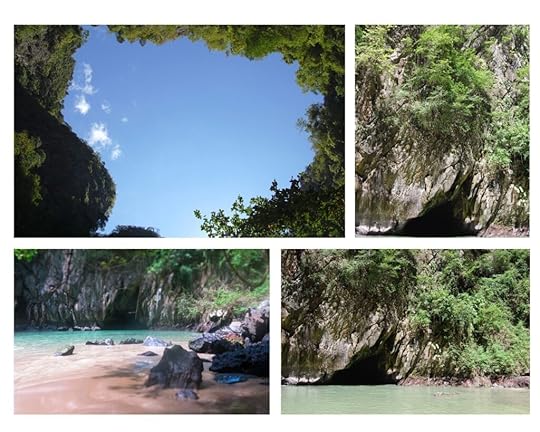 The Emerald Cave and hidden beach where the sunlight filtering through the skylight reflects a shimmering emerald colour.
The Emerald Cave and hidden beach where the sunlight filtering through the skylight reflects a shimmering emerald colour.I also used this amazing cave experience and lots of others from this trip as research for my book ‘The Backpacking Housewife.
After two days and nights we travelled from Koh Kradan by speedboat once again to the next island in the chain. And, the next island in our island-hopping adventure, is one that is often overlooked by many tourists, as it’s not often advertised or mentioned in any of the usual hotel booking sites. For this season it’s ‘off circuit’ and considered ‘far away’.
We almost overlooked it ourselves and only discovered it by chance during our trip research.
In my book, that makes Koh Bulon Lae a bit of a well-kept secret and a must-see destination!
We booked with the resort directly and, if I thought I’d found paradise before on Koh Lanta or Koh Ngai or Koh Kradan or Koh Mook, then I believe I was mistaken. Prepare yourself for Koh Bulon Lae!
KOH BULON LAE ‘Oh my… where are we. Where is this?’ And we replied, ‘It’s paradise!’
‘Oh my… where are we. Where is this?’ And we replied, ‘It’s paradise!’Koh Bulon Lae is located on the Andaman Sea between the Trang Islands and Ko Tarutao Marine Park. I can remember that the journey was fast and exhilarating and took a couple of hours.
The first thing you’ll see on approaching Koh Bulon Lae is the a beautiful white-sand beach fanned by tall swaying palm trees. Either side of the beach are limestone rocky inlets and back from the beach is dense jungle.
The backpacking husband and I were the only ones who got out of the boat at Koh Bulon Lae and upon our approach to the island, where we transferred from speedboat to longtail boat to reach the beach, everyone on board stood up and gasped in awe at what they saw. I heard someone say, ‘Oh my… this place is incredible. Where are we. Where is this?’
And we replied, ‘It’s paradise!’
Beyond all this stunning tropical island scenery, at the other side of the island, is a fishing village, some orchards, and a little school. Tourists and visitors can stay in basic guesthouses run by local families. There isn’t actually many places to stay however and so booking ahead is essential.
We stayed on White Sand Beach at Bulon Resort in a sea-view bungalow.
 Our bungalow on the beach was idyllic and our time on Koh Bulon Lae was perfect.
Our bungalow on the beach was idyllic and our time on Koh Bulon Lae was perfect.In anticipation of our stay on Koh Bulone Lae we had booked for four nights instead of the two we’d spent on Koh Ngai and the three we’d spent on Koh Kradan. We guessed we’d want to linger here, and we’d guessed right. Our stay on the island was amazing and wonderful. Our bungalow on the beach was idyllic and our time on Koh Bulon Lae was perfect.
The experience, and the island, is imprinted in my mind as an ultimate paradise tropical island.
It’s quiet and it’s laid back. It feels, somehow, other-worldly and timeless.
And, one morning, a strange thing happened. The backpacking husband and I were sitting on the beach at the waters edge with the warm clear sea lapping against our feet while we were gazing out at the sunrise, when a man appeared from the jungle behind us. A naked man.
The man was tall and very lean and quite old looking. He had wrinkly suntanned skin and long limbs and matted and straggly hair. He wasn’t Asian. He looked Western. He looked like a castaway who might have lived in that jungle an awfully long time and this was his morning route. He ignored us completely as he strode right past us and waded into the sea, where he bathed and, I can only assume, he did the other things that people usually do in the morning.
We ignored him too. We looked away, not only to give him his privacy, but because we didn’t quite know if we were shocked and appalled or rather envious of his simple island lifestyle.
After a while, he came out of the sea and walked back across the beach and disappeared into the jungle again. I watched him then and saw the path he took was marked by a driftwood and seashell dreamcatcher. I imagined that he must have a basic hut in the jungle where he lived.
I pondered on him then and his life story and sometimes I wonder if he is still there?
And, the thought of being able to stay on Koh Bulone Lae forever – living with beach access and living on fish and coconuts – for some reason, seemed like the perfect life to me!
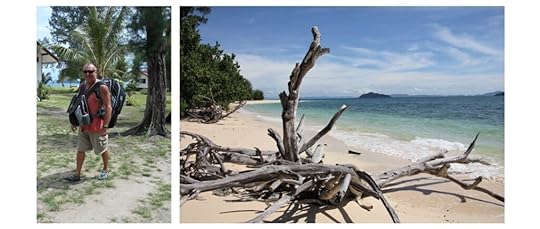 The backpacking husband with all his dive gear leaving Koh BulonKOH LIPE
The backpacking husband with all his dive gear leaving Koh BulonKOH LIPESadly, we had to leave Koh Bulon after three nights and four amazing days, and we consoled ourselves with the thought of the next beautiful island in our island-hopping adventure on the Andaman Sea Koh Lipe.
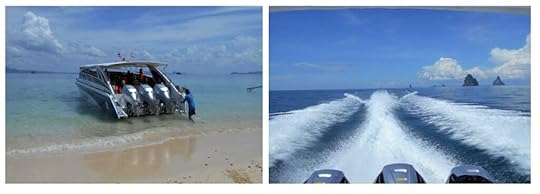 Sadly, we had to leave Koh Bulon after three nights and four amazing days there.
Sadly, we had to leave Koh Bulon after three nights and four amazing days there.Koh Lipe is the most southern island in Thailand and so it’s the last island in the Andaman chain.
Koh Lipe also serves as the Thailand border with Malaysia. Immigration is a hut on the beach and where we must hand over our passports if we are to travel on to Langkawi, Malaysia.
We had planned to stay for two nights on Koh Lipe and I was excited to experience the island.
I was looking forward to it and I’d read about its hippy vibe and hedonistic reputation and its popularity with travellers.
But, to be honest, at first glance I was rather disappointed with what I saw because it was really really busy.
I blame our gradual slide from feeling relaxed on Koh Lanta, to totally chilled on Koh Ngai, then laid back on Koh Kradan, and mostly horizontal on Koh Bulon Lae.
I feel this is why Koh Lipe, for us, was a big culture shock.
On arrival, our boat struggled to get into the bay because there were so many other boats jostling for position there.
We eventually got off the boat and walked up the beach and every stride we took was over the mooring ropes of the decorative and flower adorned longtail boats all bobbing along side by side and so close to each other that they knocked together. Swimming off the beach wasn’t an option.
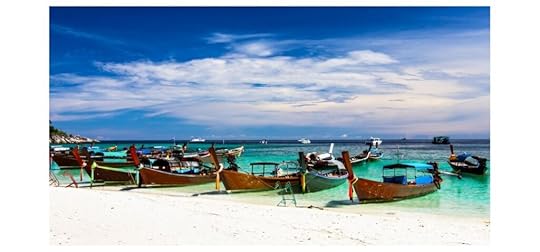 On arrival, our boat struggled to get in because there were so many other boats jostling for position there.
On arrival, our boat struggled to get in because there were so many other boats jostling for position there.And, lining the top of the beach, where we’d become accustomed to seeing green jungle and tropical foliage and colourful fragrant flowers, was stall after stall selling tourist trinkets and t-shirts.
It was all too much. Too busy. Too crowded. Too touristy. Too noisy.
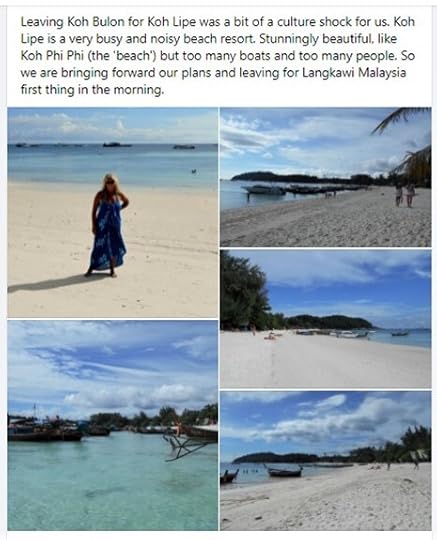 My Facebook update and thoughts on leaving Koh Bulon
My Facebook update and thoughts on leaving Koh BulonNow, I can’t speak for the whole island as there are three beaches on Koh Lipe, Pattaya, Sunrise, and Sunset beaches. and I’ve only experience one of them – Pattaya – where we’d booked to stay simply because it’s where the immigration office is to be found for onward travel to Langkawi Malaysia.
I’ve since been advised that our visit that Pattaya Beach was not the best place to stay for peace and quiet because of the boats and the noise and the crowds on walking street and the late-night bars.
So, if I do ever find myself on Koh Lipe again, I would definitely look to stay at Sunrise Beach, which is apparently the largest and the quietest of the beaches on Koh Lipe, with far less boats and lots of good hotels and restaurants in the area.
Maybe it was the initial disappointment of finding Pattaya Beach on Koh Lipe so busy, or it was our anticipation about reaching Langkawi, where we’d planned to spend a whole week exploring before moving onto the capital city of Kuala Lumpur, but we decided to cut short our stay on Koh Lipe.
We checked out early the next morning to get through immigration and to take the ferry to Langkawi Island – our gateway into Malaysia – and to many more fabulous new adventures!
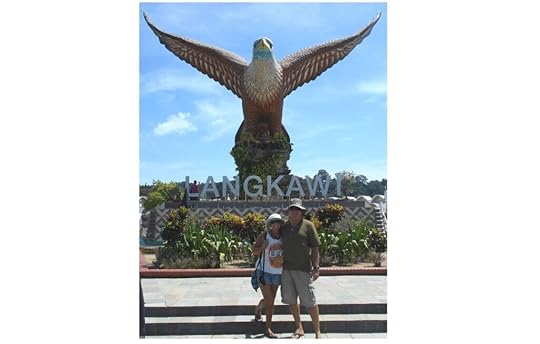 Krabi Thailand to Langkawi Malaysia
Krabi Thailand to Langkawi MalaysiaI hope you’ve enjoyed seeing my photos and reading about my experiences.
Perhaps you’ve also been to islands in Thailand?
If so, which was your favourite and why?
Are these islands on your travel bucket/wish list?
I do hope my tips are inspiring and useful to you.
Let me know!
Leave a comment below or message me on my contact page.
I’m on social media too and I’d love to hear from you or answer your travel questions.
The post Island Hopping – Andaman Sea Thailand appeared first on The Backpacking Housewife.
October 27, 2021
Island Hopping – The Seychelles
The idea a holiday in the Seychelles immediately brings to mind fabulous images of the ultimate tropical island-hopping getaway: swaying palm trees, sun-soaked white sand beaches, warm and clear azure waters… and high-end luxury resorts.
And, of course, with all that luxury we can also imagine high-priced flights and expensive hotels.
The Seychelles is an archipelago of over a hundred islands, scattered like sparkling emeralds off the east coast of Africa in the Indian Ocean, and it has always been on my travel wish list.
But, as we usually travel on a conservative budget, to facilitate our lifestyle of long term and extended slow travel, I’d only imagined that we’d ever get to the Seychelles if we squirrelled away some cash and then planned the trip meticulously to perhaps coincide with a special occasion like a wedding anniversary.
But, as it turned out, we did get to go to island hopping in the Seychelles for two fabulous weeks
And we did so entirely speculatively and at a price that suited our conservative travel budget.
“How is that possible?!” You may ask when the Seychelles is a notoriously expensive long-haul destination.
Well… there was a little bit of luck and spontaneity involved but do let me share!
How To Island Hop The Seychelles On A Modest BudgetThe backpacking husband and I were back in the UK to attend a friend’s wedding after travelling through Central America, but we’d arrived in the UK with the wedding still a little over two weeks away, having factored in some time for shopping for wedding outfits and to visit family in the UK.
And, as it happened, we managed to those things much faster than we’d anticipated.
So then… what to do for two whole weeks aside from twiddling our thumbs?
We decided on a whim to browse our usual last minute travel websites and flight search engines to see if we could get a last minute get-away and on Skyscanner (n/a – not an affiliated link) we just happened to see two seats available for THE VERY NEXT DAY going from London to Mahe in the Seychelles with Emirates (n/a) at a bargain bucket price. Pure luck? Yes!
And, whether they were last seats on the flight at a discount or a mistake price, we still don’t know!
We booked the flights without hesitation – as we’ve found that hesitation is fatal to spontaneity – and also without daring to refresh the page as we’ve discovered that’s the way a real bargain will somehow magically disappear before your eyes!
Travel Tip
We then went straight to Booking.com (n/a) and booked our first night’s accommodation on Mahe.
Let’s Go Island Hopping the Seychelles!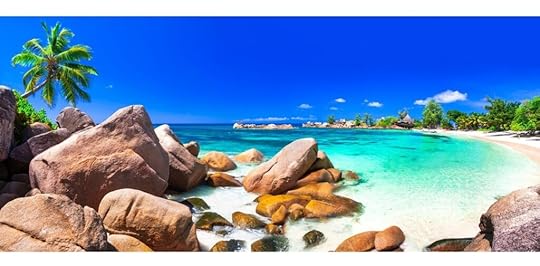 Island Hopping – Seychelles
Island Hopping – SeychellesOur plan was to arrive on the main island of Mahe, and then allow a day or two to both get our bearings, and to plan how to independently travel to some of the other islands.
Sometimes, it can be a package deal with a travel agent that will get you the best last-minute bargain holiday, but we have also found grabbing a last-minute low-priced flight and booking your own accommodation independently and online can be a great way to travel on a budget too.
Remember, if you book a package with a travel agent then you pay per person, but in booking your accommodation independently you will be paying the price of the room per night.
Travel Tip
The Seychelles are made up of inner and outer islands. Mahe is the largest island and is home to the majority of the population. It has a small and pretty capital city, Victoria, and it’s the location of the international airport. We flew from London and after a quick connecting flight in Dubai, we arrived in Mahe feeling a bit jetlagged after our long flights, but excited to arrive.
We stayed our first and our last two nights in Seychelles at a small resort hotel on a lovely beach at the popular resort area of Beau Vallon. It wasn’t the least or the most expensive option available but it was right on the beach and it also had a swimming pool and an onsite bar and restaurant.

 Our small resort hotel was on a lovely beach at the popular resort area of Beau Vallon.How To Island Hop The Seychelles On A Modest Budget
Our small resort hotel was on a lovely beach at the popular resort area of Beau Vallon.How To Island Hop The Seychelles On A Modest BudgetWe found a hotel on Mahe which we booked on Booking.com (n/a) was a perfect place to start our island-hopping adventures and to relax afterwards before our flight home. We discovered by chance that our choice of hotel on Mahe was right next door and on the same beach as The Savoy – and so for our last two days we bought a few cocktails at the pool bar at The Savoy and we used their sun terrace and loungers and pool instead of the (not quite as nice) one at our own hotel!
While on Mahe we also explore the capital Victoria – which is the smallest capital city in Africa.
We admired the historic buildings and particularly the famous and iconic landmark clock tower.
The clock tower is an emblem of previous British rule and it looks like a mini-Big Ben. It was installed in the centre of Victoria in colonial times and in 1903 in memory of Queen Victoria who died in 1901. Made of cast iron the clock is a replica of the one at the entrance to Victoria Station in London in 1892 that commemorated Queen Victoria’s Diamon Jubilee.
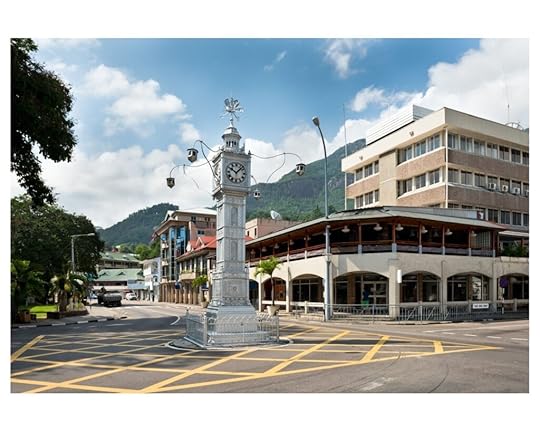
The iconic clock tower has now presided over the city centre for over one hundred years and, although it was originally painted black, it is now painted silver. It otherwise remains the same, whereas the town around it has changed with the times.
Praslin IslandHaving fully recuperated from our jetlag, we made plans to travel to the much smaller island but second largest of the inner islands called Praslin – an island famed for its many beautiful beaches and its jungle interior and its national park – the Vallée de Mai Nature Reserve.
We took a high-speed catamaran ferry over to Praslin with a ferry company called Cat Cocos (n/a).

My backpacking husband was looking forward to the world class scuba diving from Praslin, and I was particularly interested in seeing the beautiful flora and fauna and the tropical beaches bordered with giant granite boulders, for which the Seychelles are famous. Praslin is also where you can find the famous and indigenous Coco de Mer nut.
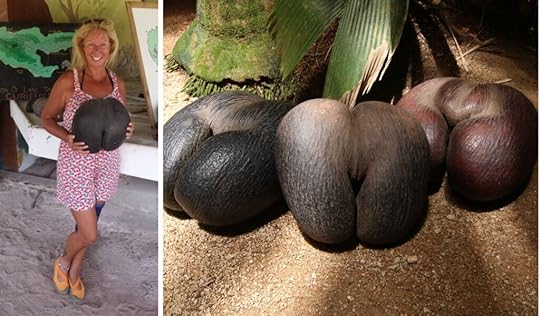

 The Seychelles is famous for tropical beaches bordered with giant granite boulders.How To Island Hop The Seychelles On A Modest Budget
The Seychelles is famous for tropical beaches bordered with giant granite boulders.How To Island Hop The Seychelles On A Modest BudgetWe alternated our days exploring Praslin island and lounging at the hotel pool or hanging out at the beach, snorkelling and scuba diving with the local dive centre, and also taking island hopping days out by booking boat trips and tours.
The ferry from Inter Island Quay, Victoria, to Praslin Quay takes one hour depending on sea conditions.
I found the journey surprisingly rough. I felt horribly seasick and made a mental note to myself to be sure to take a sea sick pill on the return journey. Despite this, I would highly recommend Cat Cocos fast ferry to you and you can find schedules and book tickets via their website (n/a).
On Praslin, we based ourselves at a hotel and beach resort at Anse Volbert Village. Again, a mid-priced and affordable hotel, not too far away in distance but a world away from high-priced hotels like Raffles, just along the coast.
From our hotel, we were able to hire a car and driver for a morning to take us all around the island and to the main sights of Vallée de Mai Nature Reserve and all the best beaches and we also took a tour of The Black Pearl Farm – which I used as research for my bestselling romantic adventure novel (affiliated link) Island In The Sun.
Then, from Praslin, it looked relatively easy to take day trips to all the smaller outer islands.
 My visit and tour to the Black Pearl Farm on Praslin was research for my novel Island In The Sun.La Digue Island
My visit and tour to the Black Pearl Farm on Praslin was research for my novel Island In The Sun.La Digue IslandWe took a small ferry boat to explore La Digue, the fourth largest inhabited island in the Seychelles, but still a comparatively tiny island considering its popularity. La Digue was named after the ship that French naval captain Marc-Joseph Marion Fresne first sailed to the Seychelles in 1768. The island is stunningly beautiful – like a picture postcard – and it is surrounded by powder soft white sand beaches and warm clear water and coral reef.
It’s just a twenty minute boat trip to La Digue from Praslin.
La Digue is a car free island, so we hired bicycles to cycle along sandy pathways through the coconut palm forests of the interior, until we came across the world famous – and most photographed beach in the world – the beach at Anse Source D’Argent.


 Curieuse Island
Curieuse IslandAn absolute highlight of our time was our wonderful day spent on the tiny granite Curieuse Island.
The island was once called Ile Rouge for its red soil and, from 1829 until 1965, the island was used as a leper colony. Indeed, the original Doctor’s house on the island, a Creole style building from that era that we also visited, is now completely restored and offers a small museum to tourists.
Curieuse Island is also, importantly, the primary home of the Coco de Mer palm trees.
Praslin, as I mentioned earlier to you and where I found the famous nut, is the only other place in the world to find the Coco de Mer nut growing in the UNESCO nature reserve.
But it is Curieuse Island that has the only natural Coco de Mer forest.
On Curieuse, I was keen to spent some up close and personal time with the 300 or so free roaming Aldabra giant tortoises that live on the conservation reserve as a colony and who are apparently completely unfazed by tourists.
The oldest of these magnificent creatures are well over one hundred years old. The oldest, perhaps 120 years old, although we were told by a ranger some can live up to 200 years but this is difficult to verify as they outlive their human caretakers and observers.


According to Wikipedia: as of 2016, Jonathan, a Seychelles giant tortoise is thought to be the oldest living giant tortoise at the age of 189 years. And Esmeralda, an Aldabra giant tortoise, is second at the age of 177 years. How incredible!
 When Is The Best Time To Visit The Seychelles?
When Is The Best Time To Visit The Seychelles?Situated just south of the equator, the islands of the Seychelles are bathed in warm sunshine most of the year and they experience just two seasons – wet and dry – and it’s the trade winds that usually dictate the weather.
The wet and rainy season is from November to March.
January and February are the cooler wettest months.
The dry season is when a south-easterly breeze blows across the islands between May to September. And so, the relatively wind free ‘shoulder’ months of April and October are considered the best time to visit the Seychelles with calmer seas and less chances of rainy days. We visited the Seychelles during the end of July.
June, July, and August, are classed as high season for tourism in the Seychelles.
In July, and during the time of our visit, the cooler southernly trade winds are known to cause a high sea swell between Mahe and Praslin, which is why we found our crossing to be a little rough.
Otherwise, in July, we found the weather to be idyllic and temperatures around 27-30 deg C.
To Conclude:How To Island Hop The Seychelles On A Budget
At the time of writing, to find costings comparative to our own experience of island hopping the Seychelles, I did a quick check on current prices for accommodations for the month of July with smaller hotels and resorts on the Seychelles and specifically the islands of Mahe and Praslin.
I searched on Booking.com (not an affiliated link) because that’s the accommodation website that I used myself. And, although obviously the sky is the limit if that suits your budget (for example Raffles on Praslin is currently priced at £856 per room per night) the prices of accommodations you can book online classed by guests as ‘very good’ and ‘exceptional’ can be very reasonably priced from £65 per room per night.
So, if you can be super flexible and impulsive – and you can see heavily discounted seats on a flight to the Seychelles and you then independently book reasonably priced accommodation online (and I’m NOT talking about hostel rooms or shared facilities here) – then it’s absolutely possible to visit the Seychelles on a far more modest budget than you might think and that many travel agencies would have you believe.
Please note that I recommend taking out comprehensive travel insurance from the time of booking travel. This is especially important when you are booking travel independently – and not covered by ABTA – in order to fully protect your travel costs.

I hope you’ve enjoyed seeing my photos and reading about my experiences in the Seychelles.
I do hope my tips are inspiring and useful to you.
Perhaps you’ve also been to The Seychelles?
If so, what was your favourite thing to do there?
Or are The Seychelles on your travel bucket/wish list?
Let me know!
Leave a comment below or message me on my contact page.
I’m on social media too and I’d love to hear from you or answer your travel questions.
The post Island Hopping – The Seychelles appeared first on The Backpacking Housewife.



